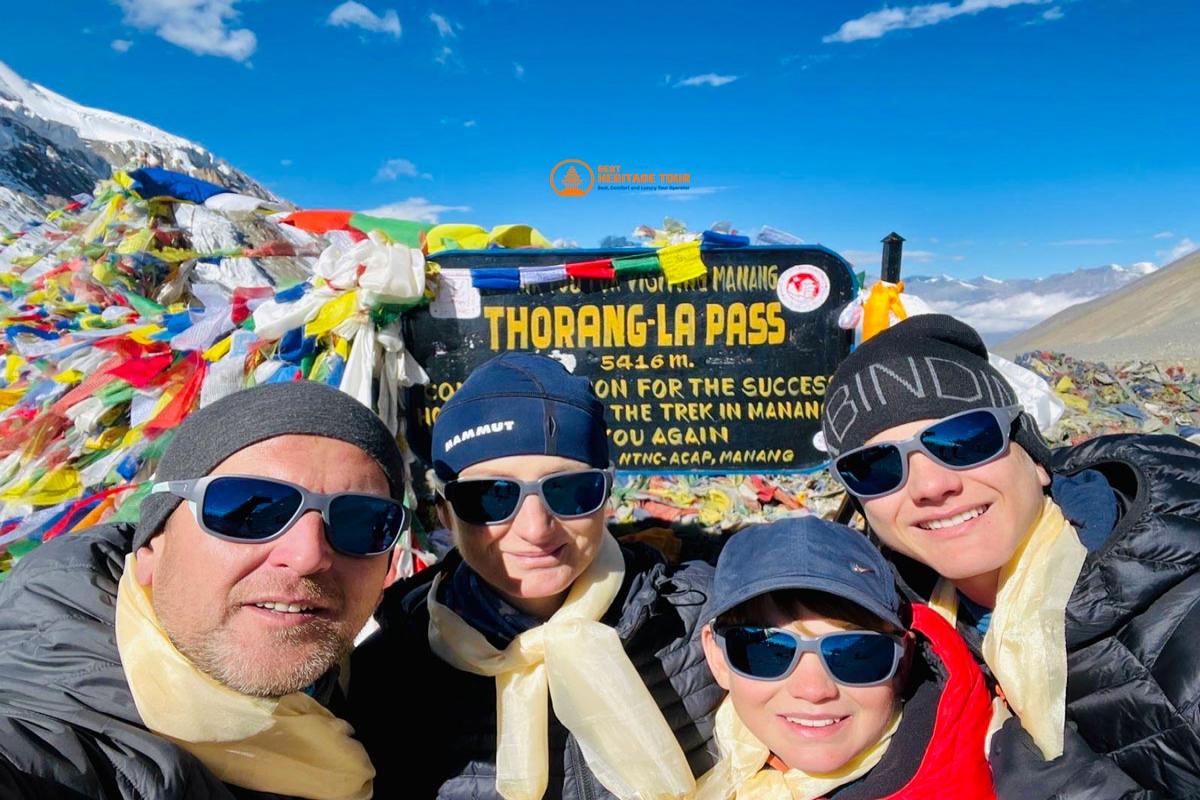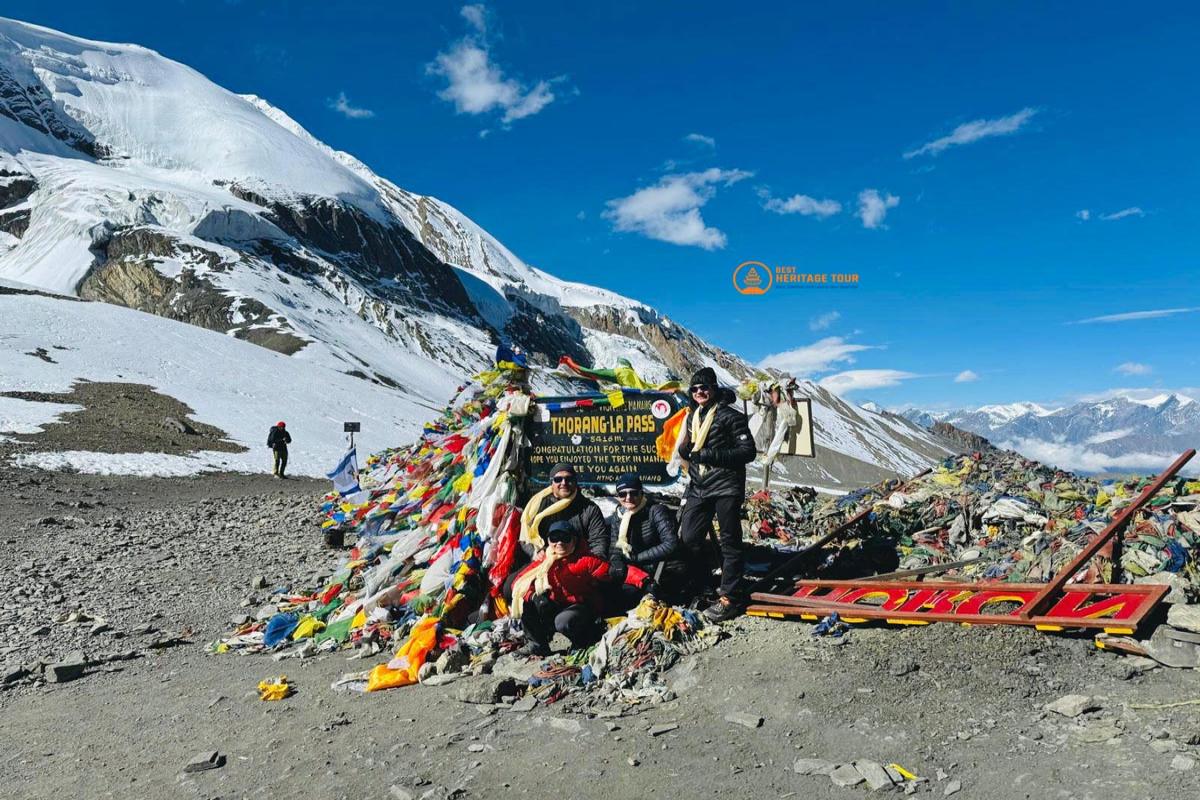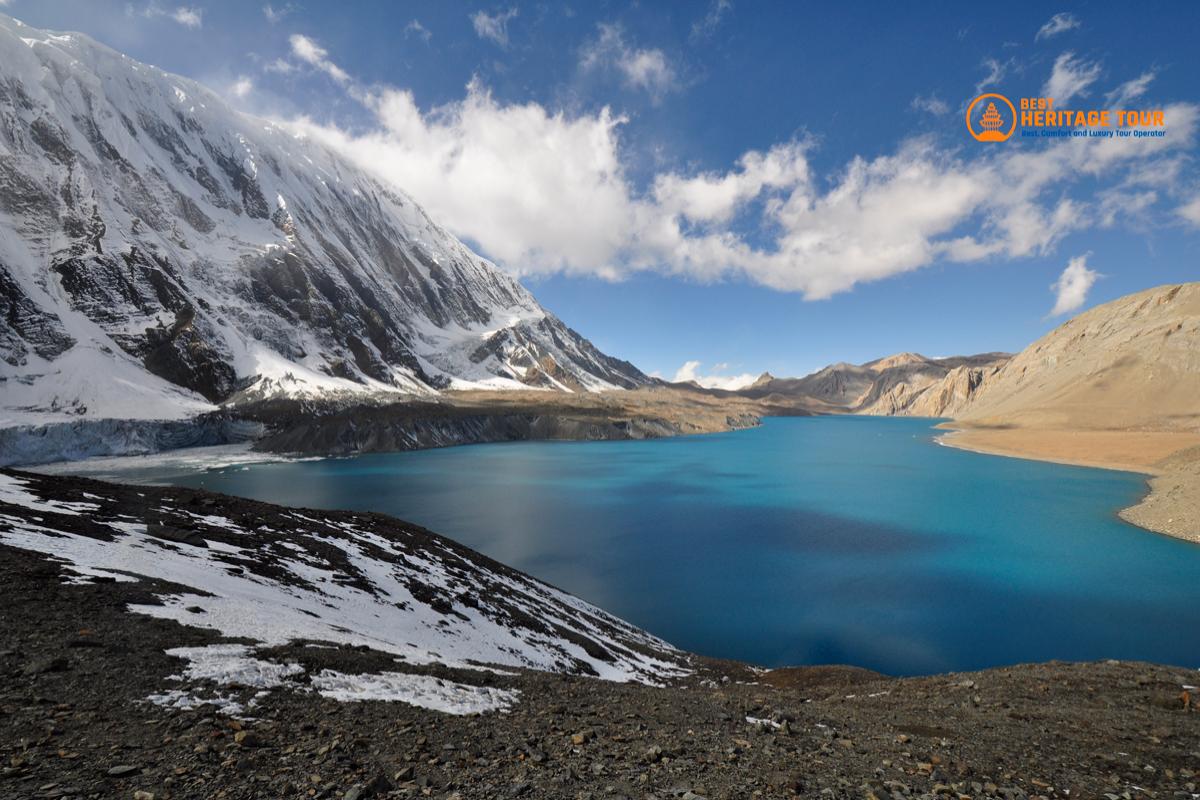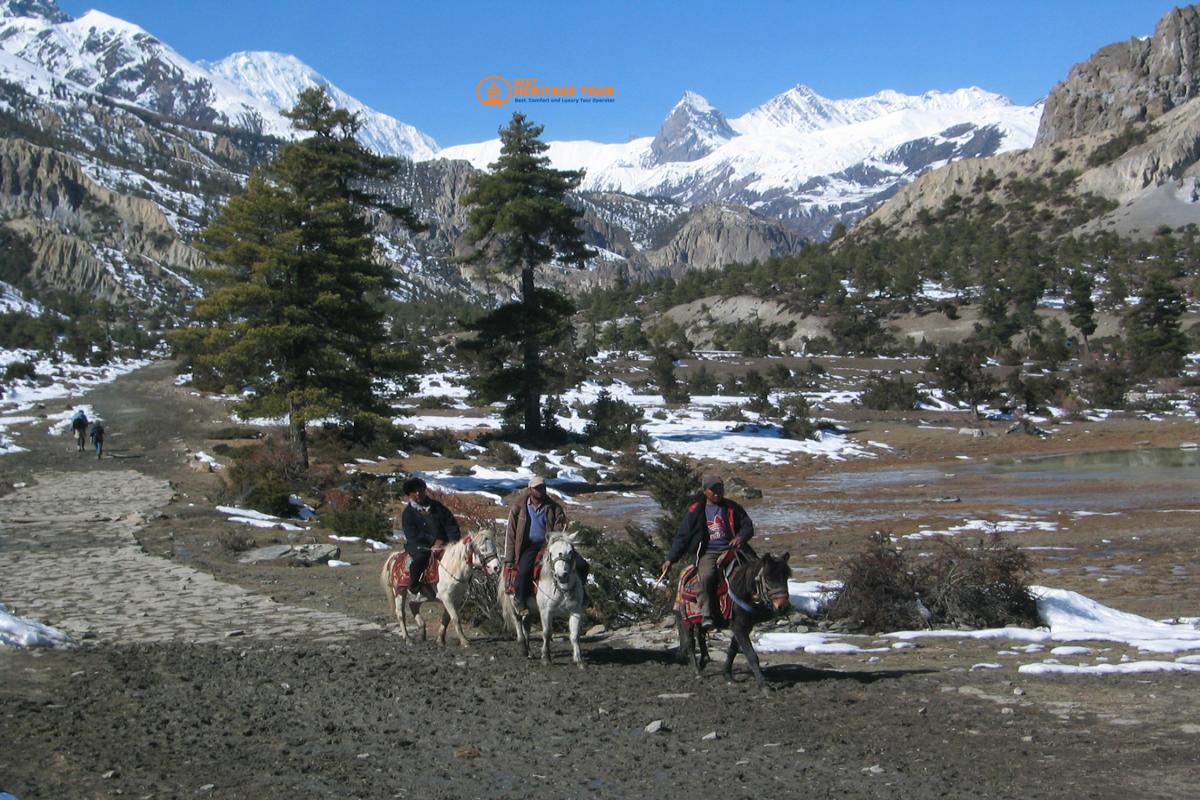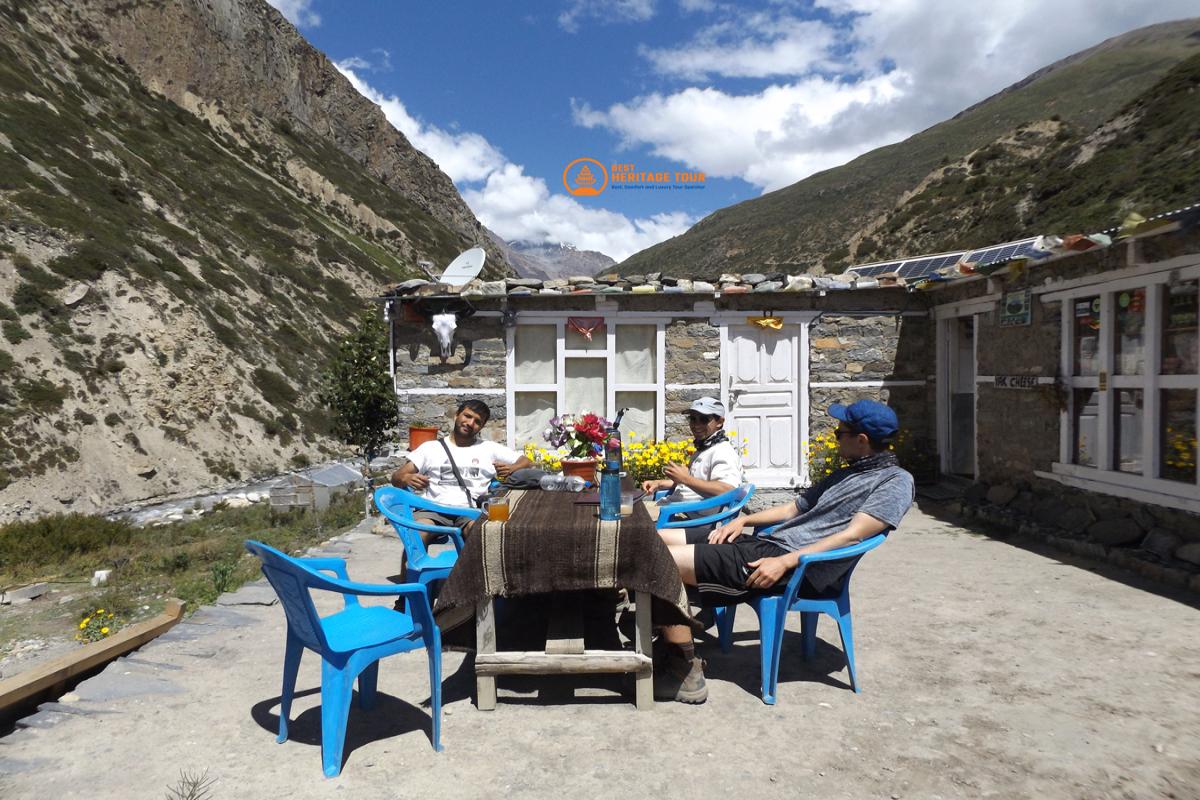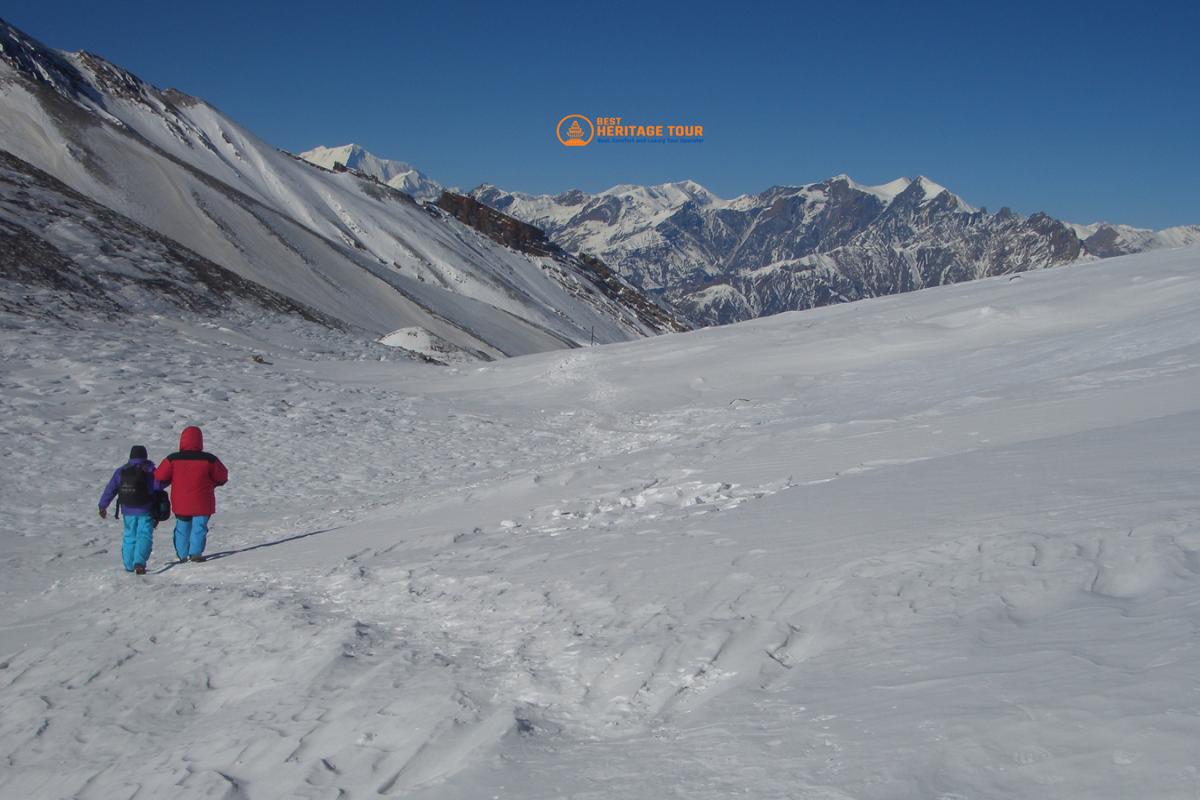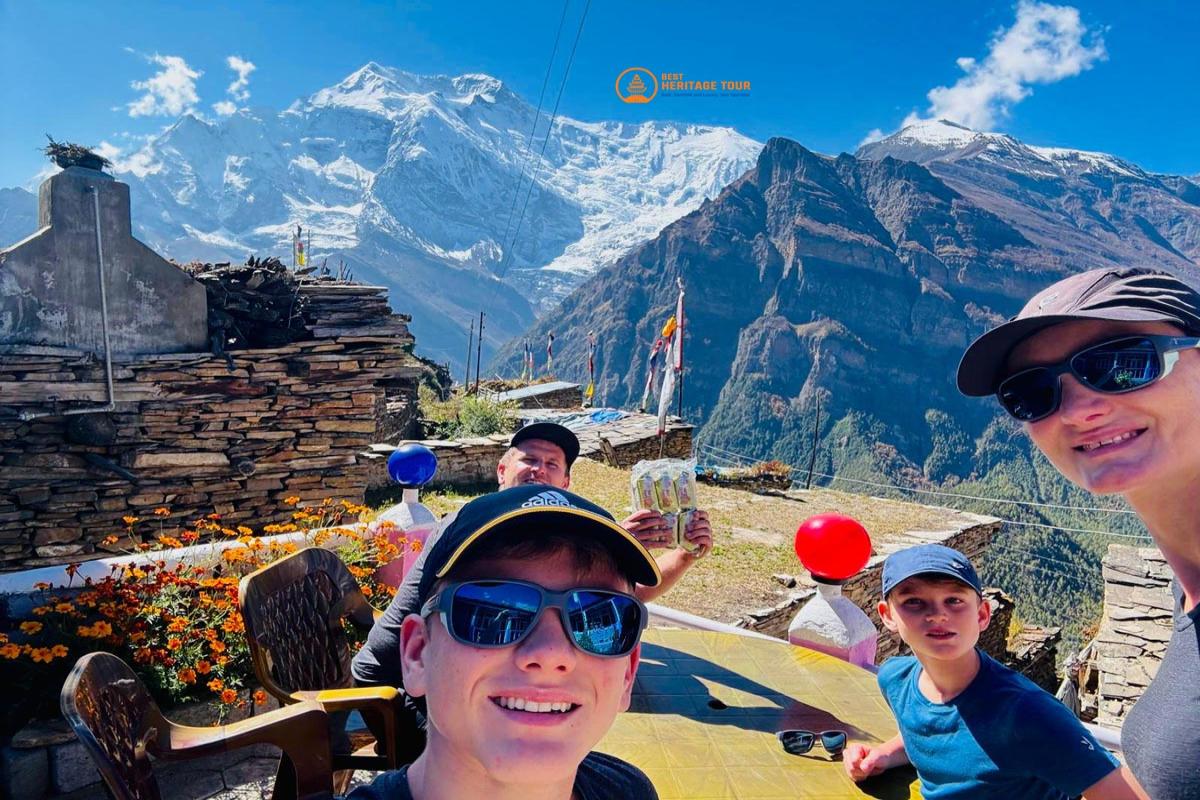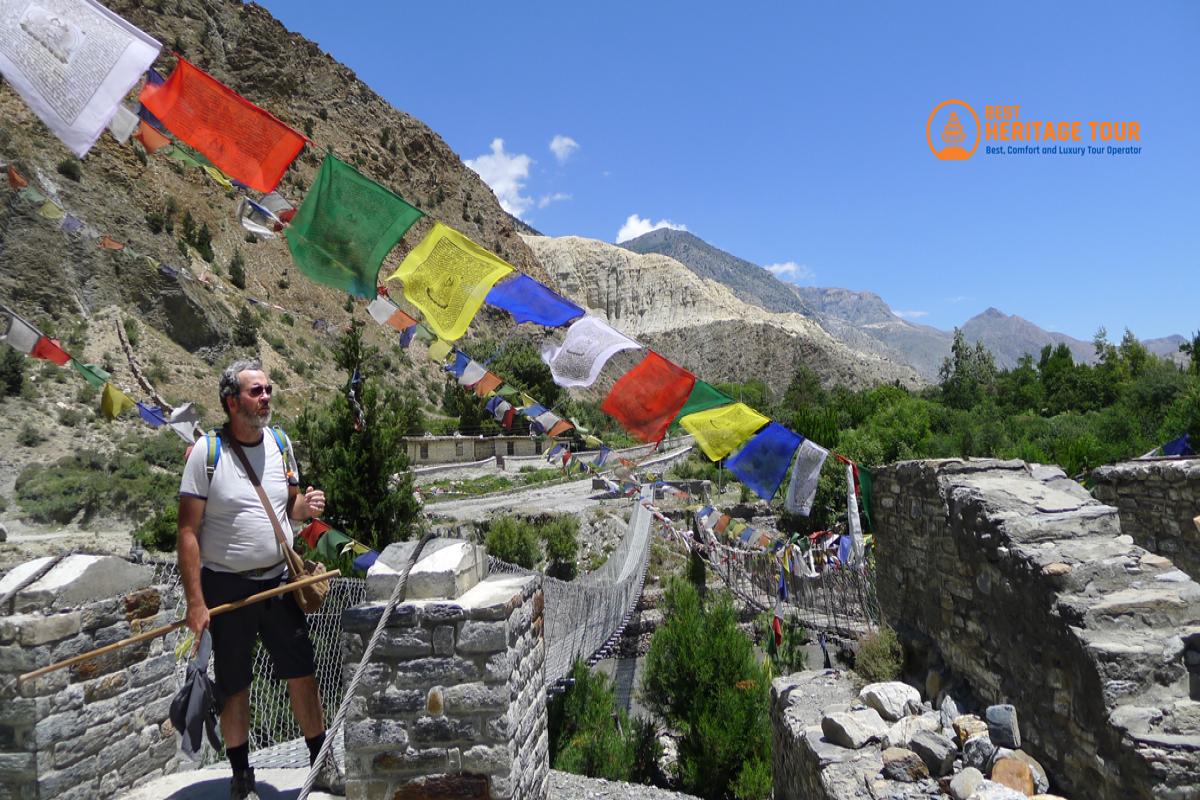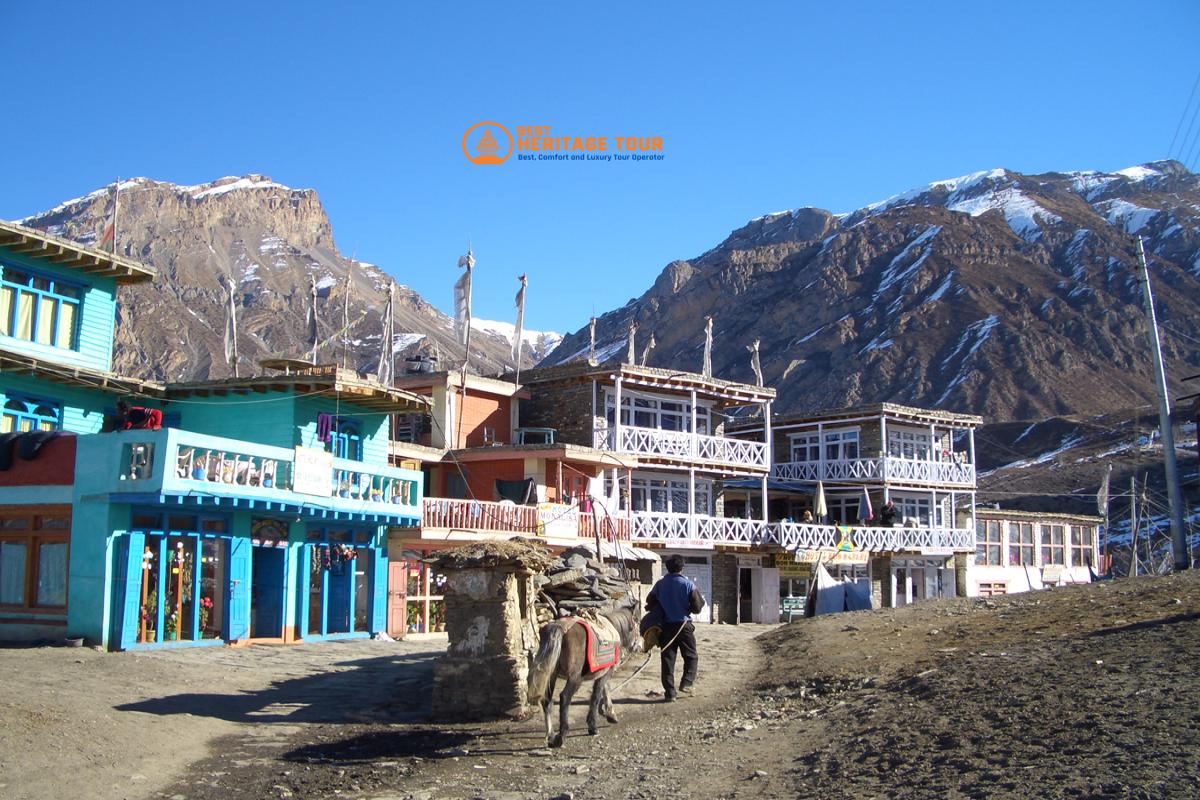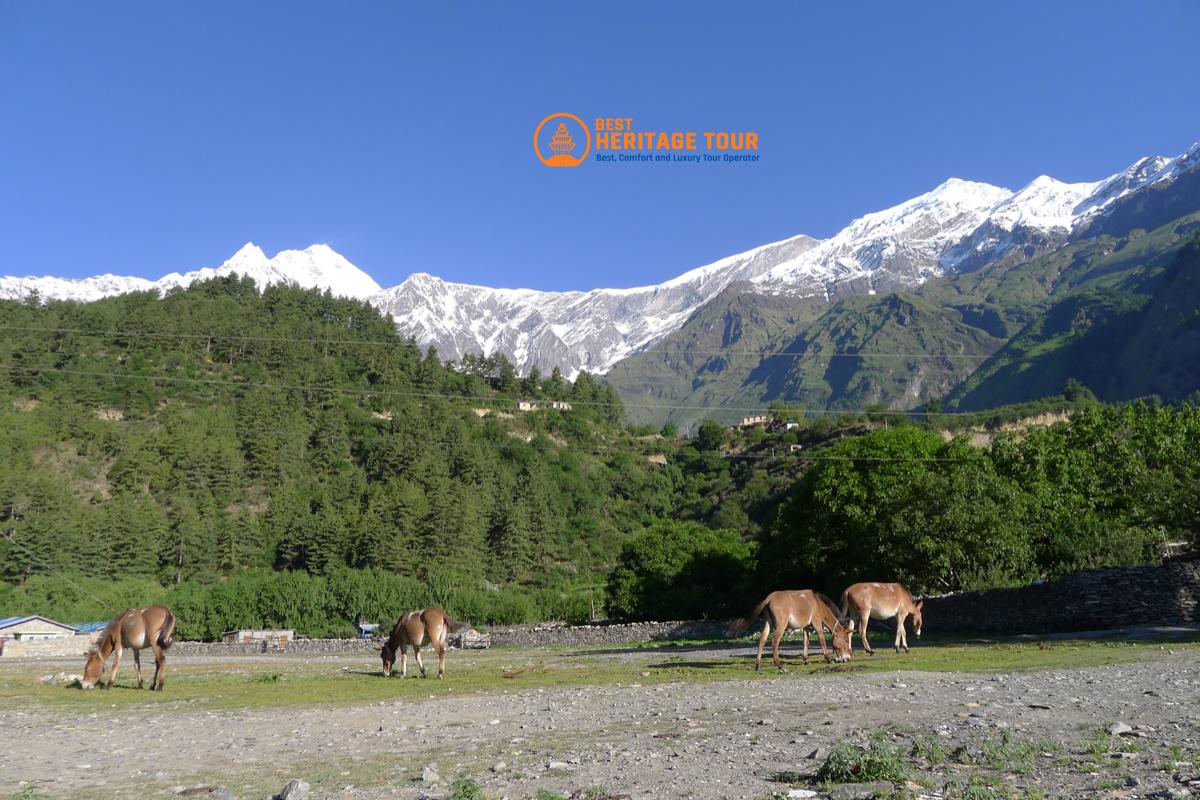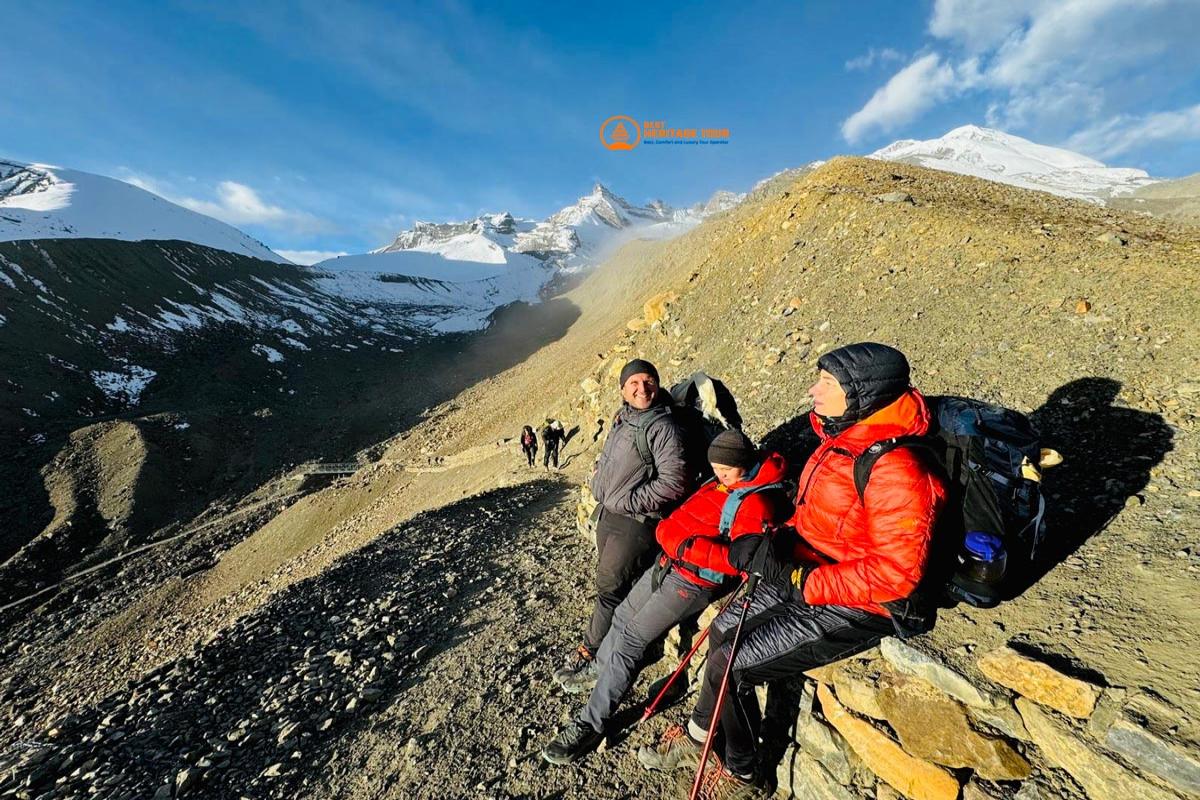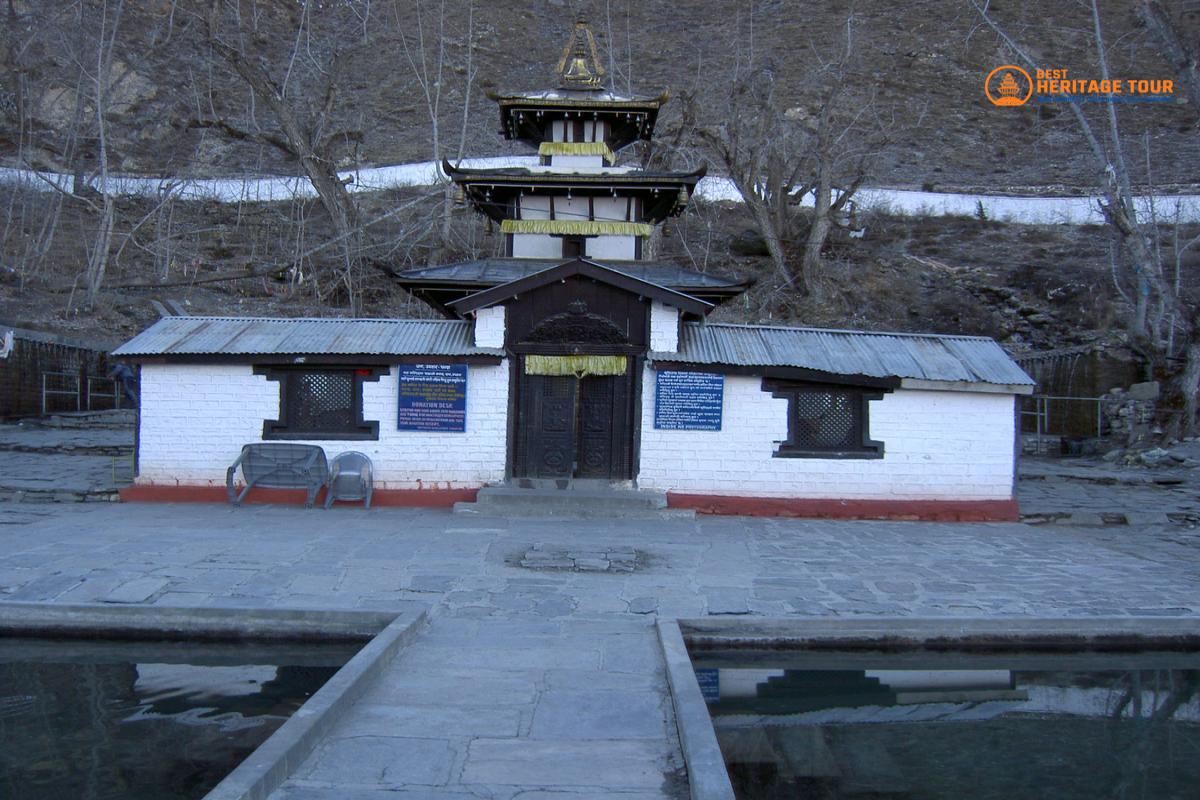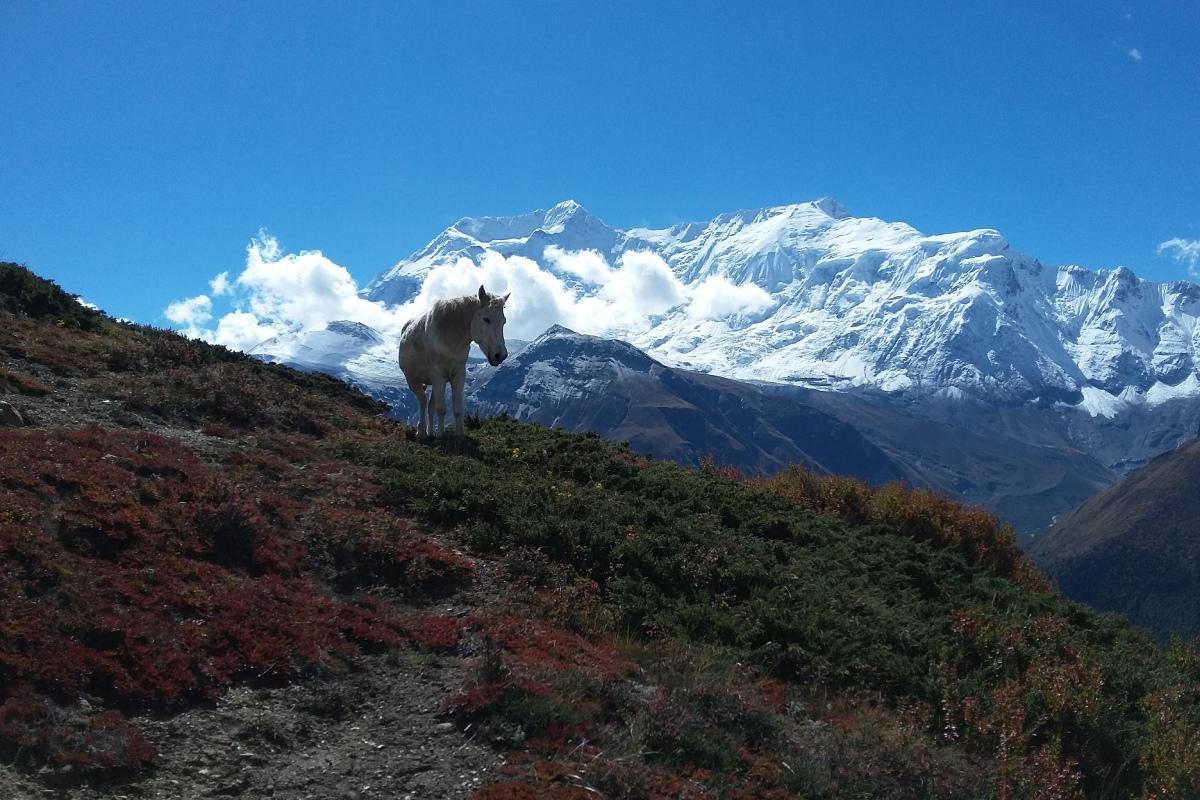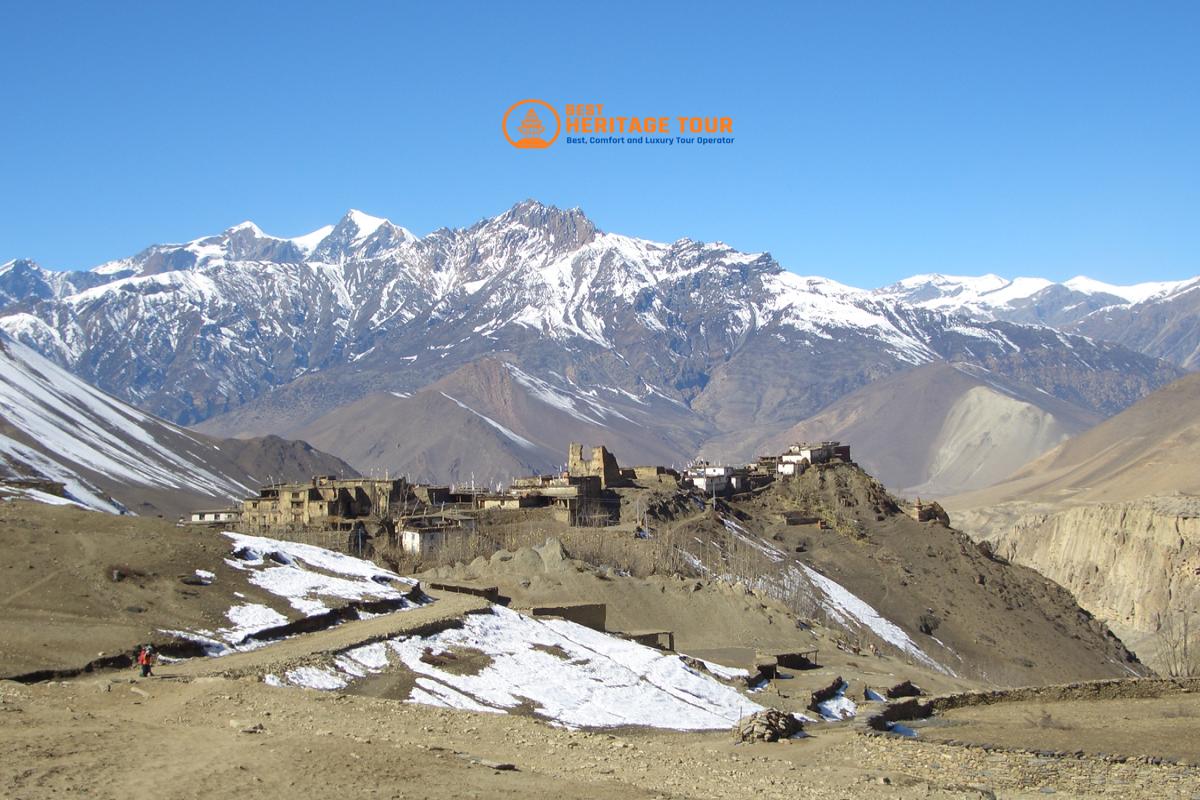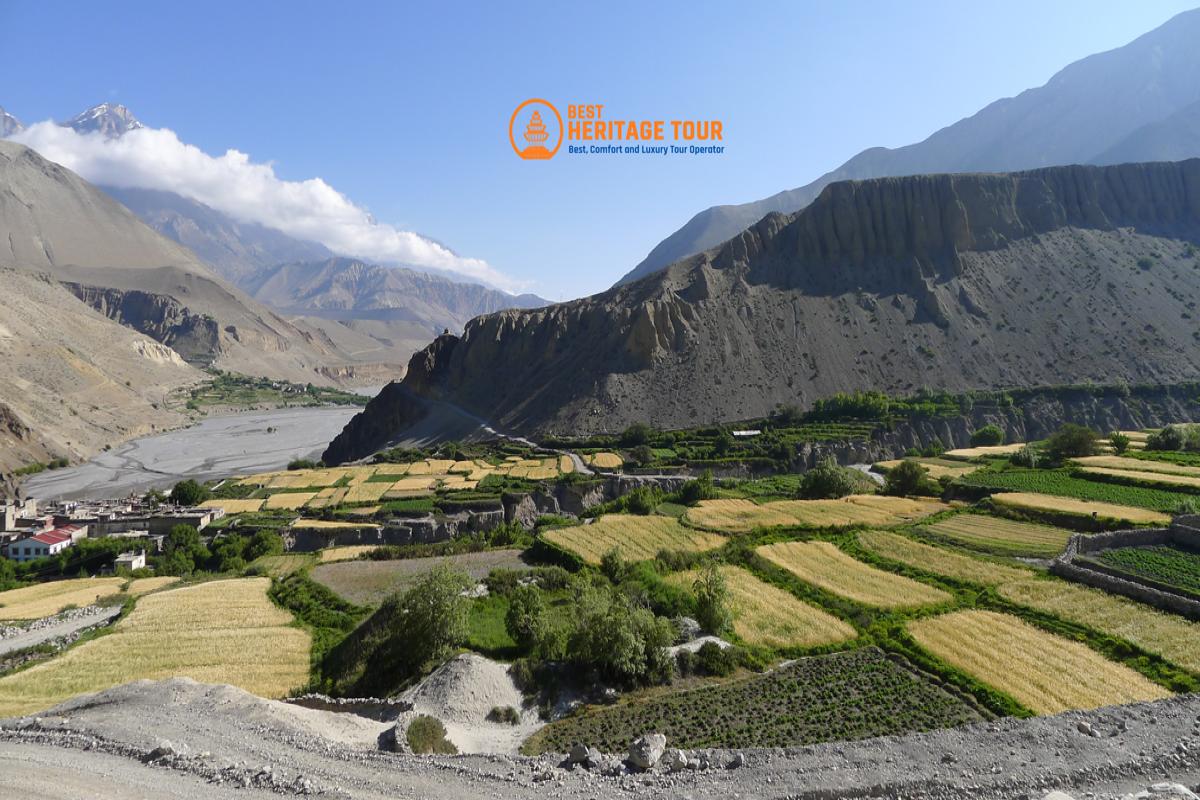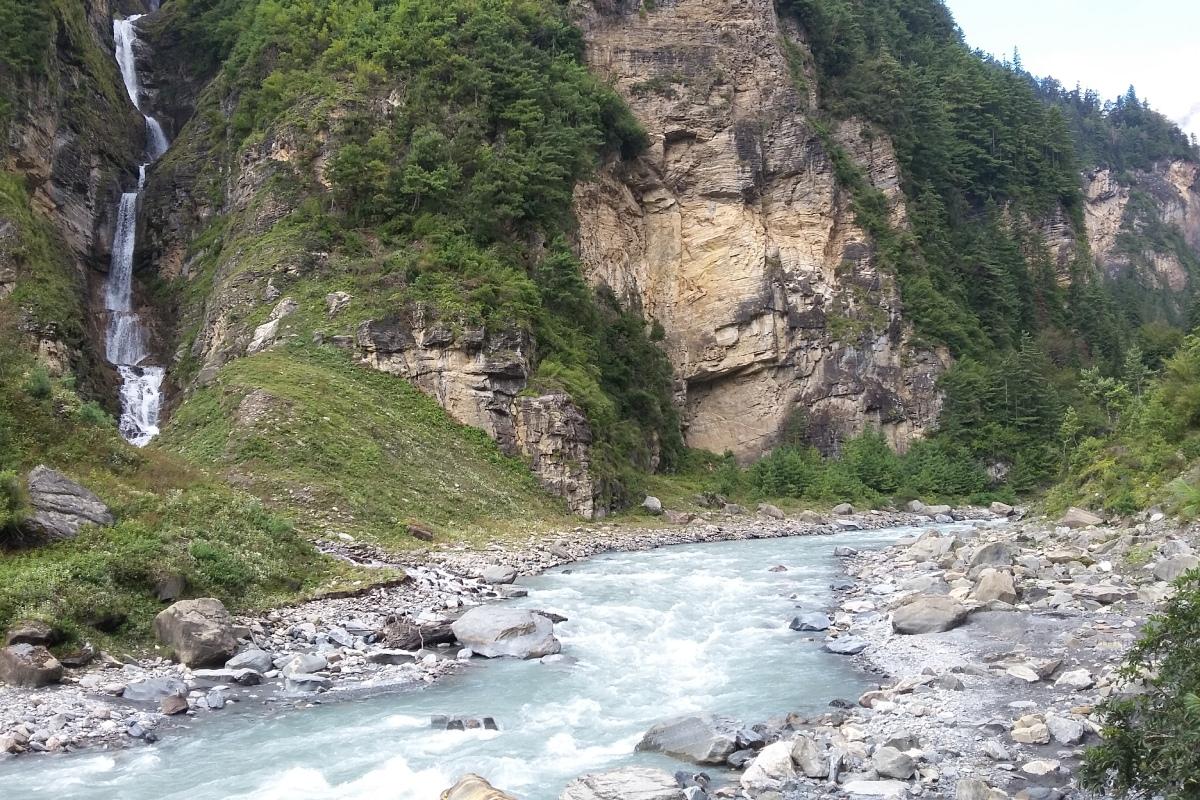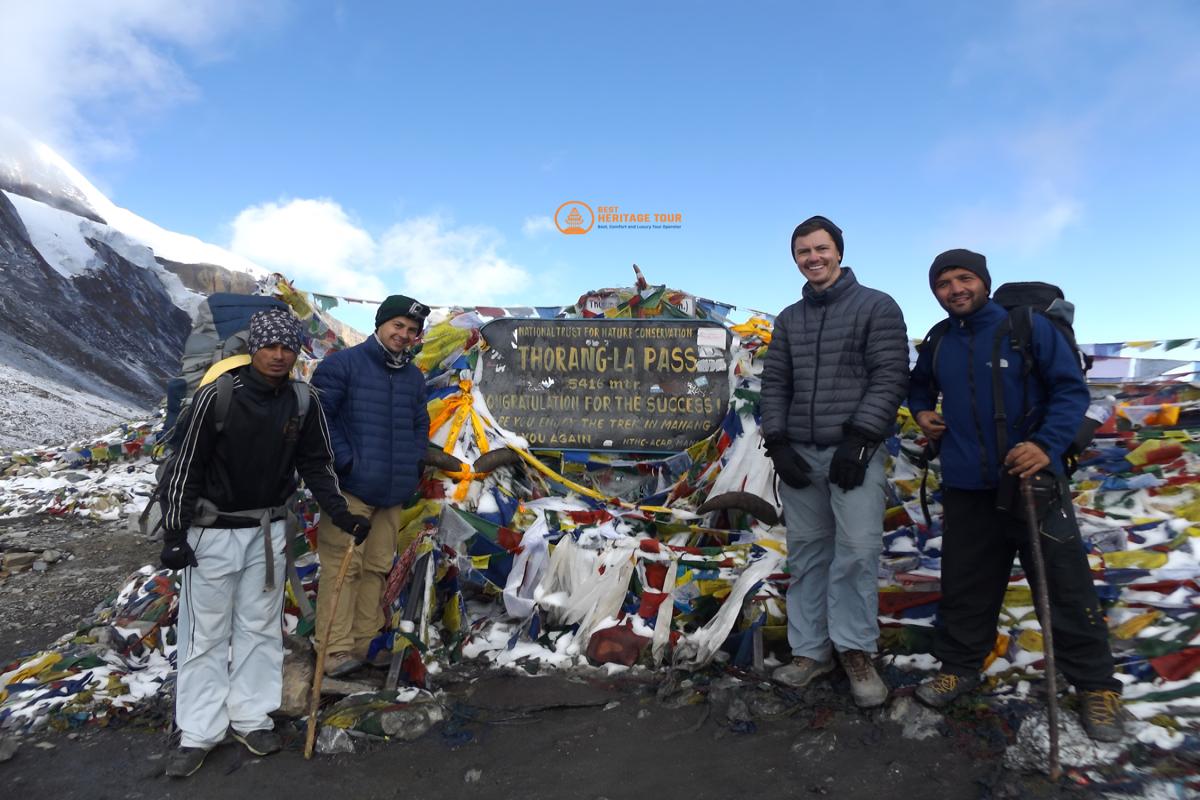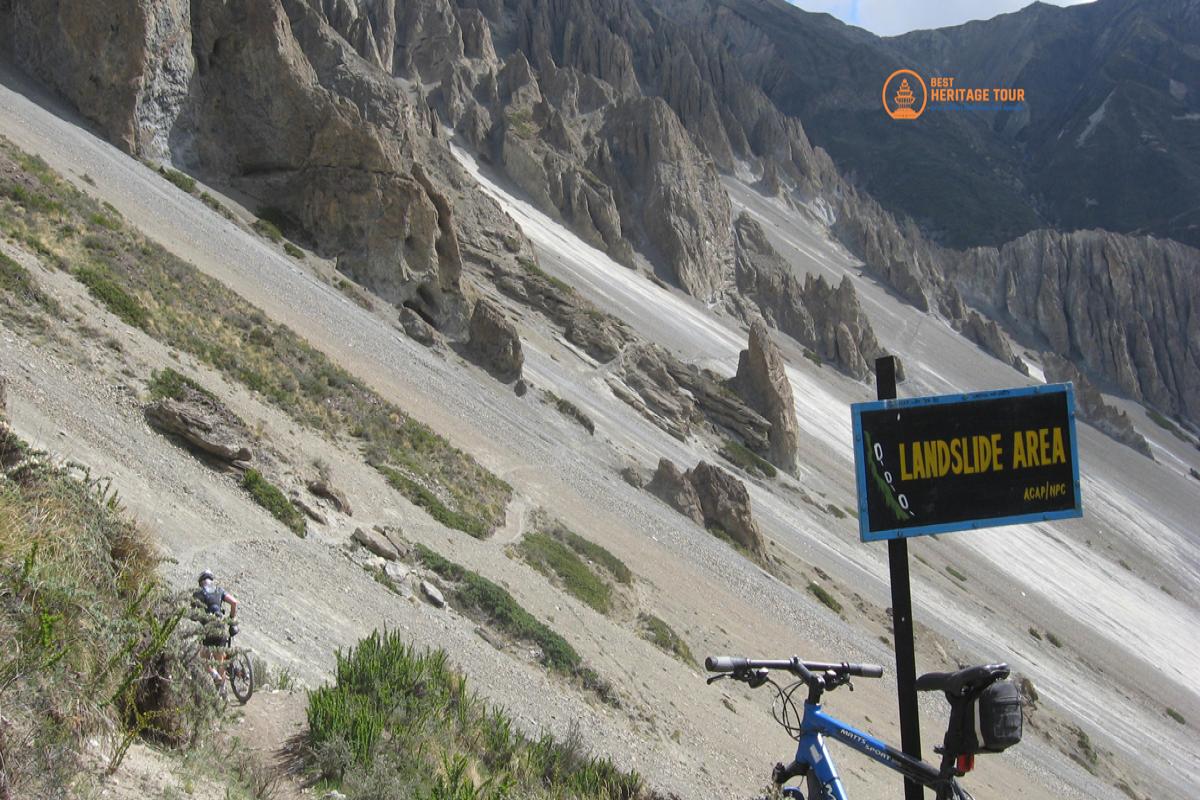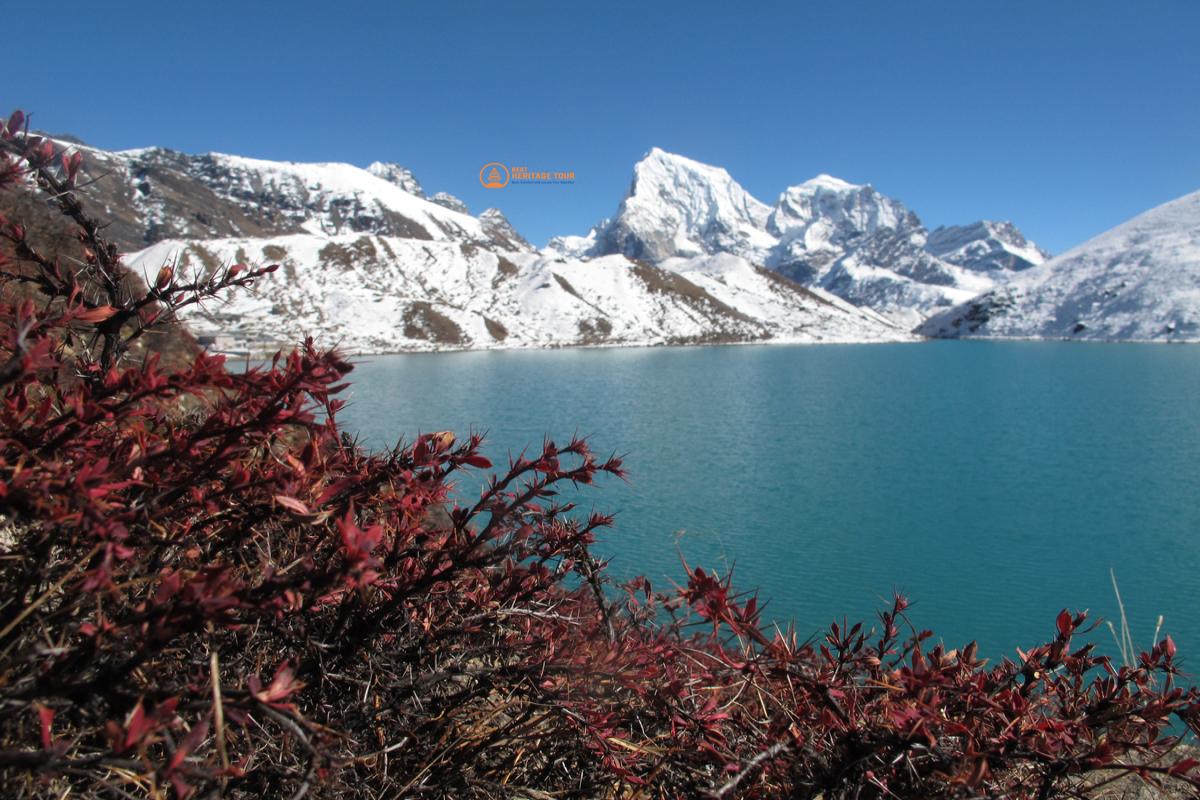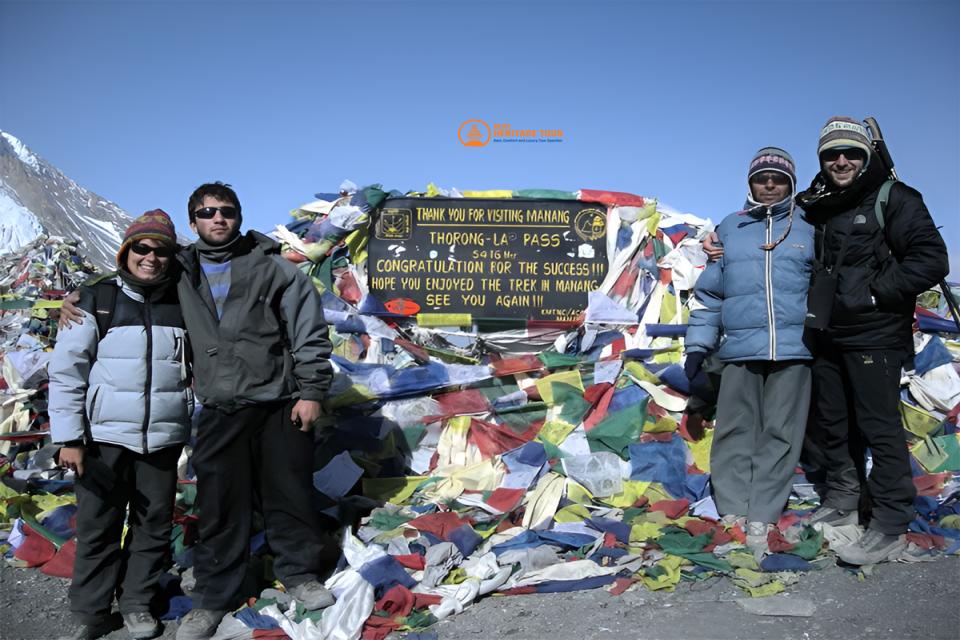Annapurna Circuit Trek with Tilicho Lake - 16 Days
Insight on Annapurna Circuit Trek with Tilicho Lake
The Annapurna Circuit Trek offers an exhilarating adventure through lush valleys, rugged mountain trails, and remote Himalayan villages. Trek across the legendary Thorong La Pass (5,416m), explore serene high-altitude lakes like Tilicho Lake, and soak in panoramic views of Annapurna, Dhaulagiri, and Machapuchare. This journey blends thrilling challenges, breathtaking landscapes, and cultural encounters, from terraced farmlands to traditional villages. With every step, trekkers experience the raw beauty of Nepal’s Himalayas and the sense of achievement that comes with conquering one of the world’s most iconic treks.
Trip at a Glance
Key Highlights
- Enjoy panoramic views of Annapurna, Dhaulagiri, Machapuchare, and surrounding peaks.
- Conquer Thorong La Pass - one of the world’s highest trekking pass at 5,416 meters.
- Explore Tilicho Lake - one of the highest lakes in the world, surrounded by dramatic mountains.
- Walk through traditional villages like Manang, Muktinath, and Ghorepani, visiting monasteries and temples.
- Visit Muktinath Temple - a holy place for Hindu and Buddhist
- Explore Bhaji Monastery, largest monastery in Manang district
- Explore different terrain - from lush forests and terraced farmlands to alpine meadows and high desert terrain.
- Cross suspension bridges and follow river valleys with flowing waterfalls, including the Kali Gandaki.
- Sunrise at Poon Hill to witness a breathtaking sunrise over Annapurna and Dhaulagiri
Benefits of Annapurna Lake and Tilicho Lake Trekking with Best Heritage Tours
- Free transfers between airports with private transport on arrival and departure
- First aid kit and pulse oximeter to monitors blood oxygen saturation at high altitudes to detect early signs of altitude sickness and other potential health risks.
- Easy booking and reservation system
- Easy payment system
- Multiple Communication Channel (email, WhatsApp, WeChat, , Skype, Zoom Viber Facebook,)
- 24/7 phone service at: +977-9851149197/+977-9810043046
- Free storage service for excess luggage during the trek
- Provide sleeping bag and trekking poles, if you don't have your own
Trip Overview
The Annapurna Circuit Trek is one of Nepal’s most celebrated and rewarding Himalayan journeys, offering a perfect blend of adventure, natural beauty, and cultural immersion. The trek begins in the lush lowlands of Besisahar, gradually winding through fertile terraced fields, quaint villages, and dense forests, giving trekkers a first glimpse into the rich rural lifestyle of Nepalese communities. Along the way, the trail follows the Kali Gandaki River, which flows through deep, dramatic gorges framed by towering cliffs, creating a sense of scale and grandeur that is unmatched.
As the journey ascends, the landscape transforms dramatically. Green hills give way to alpine meadows and high desert plateaus, where the snow-capped peaks of Annapurna, Dhaulagiri, Machapuchare, and several other towering mountains dominate the horizon. Trekkers experience a remarkable diversity of ecological zones, passing through rhododendron forests, pine and oak woodlands, and stark high-altitude terrain. The villages scattered along the trail, such as Manang, Muktinath, and Ghorepani, offer a window into local traditions, ancient monasteries, and vibrant festivals, providing cultural depth to the trekking experience.
Among the trek’s highlights are hidden gems like Tilicho Lake, one of the highest lakes in the world, surrounded by towering cliffs and pristine landscapes. The challenging Thorong La Pass at 5,416 meters is a defining moment of the trek, testing both endurance and determination while rewarding hikers with panoramic Himalayan vistas and a profound sense of accomplishment.
The descent from the high mountains takes trekkers through lush rhododendron forests, terraced farmland, and small settlements, offering moments of reflection on the journey’s beauty and cultural richness. Ending near Pokhara, the trek combines adventure, serenity, and authentic Himalayan life, making it an unforgettable experience. Ideal for both seasoned trekkers and enthusiastic adventurers, the Annapurna Circuit Trek offers a complete Himalayan journey - one that inspires awe, challenges the body, and leaves lasting memories of Nepal’s natural and cultural heritage.
What to Expect on Annapurna Circuit Trek
1. Iconic Himalayan Views
The Annapurna Circuit Trek offers breathtaking panoramic vistas of some of the world’s most famous peaks, including Annapurna, Dhaulagiri, and Machapuchare. From snow-capped ridges to rugged valleys, every stage of the trek presents a constantly changing visual feast. Photographers and nature enthusiasts will find countless opportunities to capture the raw beauty of the Himalayas in all their grandeur.
2. High-Altitude Adventure
Cross the legendary Thorong La Pass at 5,416 meters, a highlight of the trek. This high-altitude challenge tests both physical endurance and mental strength, but the effort is rewarded with sweeping mountain panoramas, deep valleys, and a profound sense of accomplishment. The journey across the pass is an unforgettable experience that defines the Annapurna Circuit Trek.
3. Tilicho Lake Exploration
Visit Tilicho Lake, one of the highest lakes in the world at 4,920 meters. Surrounded by towering peaks, glaciers, and dramatic cliffs, the lake provides a serene, otherworldly landscape. Trekkers can enjoy quiet reflection, photography, and the sheer majesty of high-altitude wilderness. Its turquoise waters against the stark rocky backdrop create an iconic Himalayan scene.
4. Cultural Encounters
Experience the unique cultures of the Annapurna region by walking through villages such as Manang, Muktinath, and Ghorepani. Trekkers can witness traditional lifestyles, local rituals, and vibrant festivals, as well as visit ancient monasteries, temples, and stupas. These cultural interactions offer deep insights into the spiritual and daily lives of the mountain communities.
5. Diverse Landscapes
The trek passes through a remarkable variety of terrains, from lush subtropical forests and terraced farmland to alpine meadows and high desert regions. Each day brings a new ecological experience, including rhododendron blooms, pine forests, and stark mountain deserts, providing a rich backdrop for adventure and exploration.
6. Rivers, Valleys, and Waterfalls
Cross numerous suspension bridges, trek alongside rivers, and admire cascading waterfalls, including the iconic Kali Gandaki River. These natural features not only add visual beauty but also enhance the sense of adventure and connection with the Himalayan environment.
7. Sunrise at Poon Hill
The trek culminates with the sunrise at Poon Hill, one of Nepal’s most celebrated viewpoints. Watching the morning sun illuminate Annapurna and Dhaulagiri is a spectacular, unforgettable experience, offering panoramic vistas that leave a lasting impression on every trekker.
Itinerary
Your Annapurna Circuit adventure begins with a journey from Kathmandu to Besisahar using public transport, winding through picturesque hills, terraced farmlands, and flowing rivers. The drive offers stunning views of lush valleys, small settlements, and scattered forests, giving a first glimpse of the rural Himalayan landscape. From Besisahar, you transfer to a public jeep that takes you to Jagat, the official starting point of the trek. The road passes through charming villages, dense forests, and the Kali Gandaki river valley, setting the tone for the trek ahead. Upon arrival in Jagat, you can settle into your lodge, enjoy a warm meal, and soak in the serene surroundings of this quaint mountain village.
Today, your trek begins in earnest as you leave Jagat and follow the Kali Gandaki river valley, one of the deepest gorges in the world. The trail winds through lush subtropical forests, terraced farmlands, and traditional villages where you can observe daily rural life. Along the way, you cross suspension bridges spanning the river, offering stunning views of the surrounding cliffs and the river’s turquoise waters. Small temples, Mani walls, and prayer flags line the trail, giving a glimpse into the rich cultural and spiritual heritage of the region. The climb to Dharapani is gradual but steady, allowing you to acclimatize gently while taking in the breathtaking scenery of terraced fields, cascading waterfalls, and forested hills.
The trail today climbs steadily along the Kali Gandaki River valley, offering panoramic views of towering cliffs, lush forests, and terraced fields. You will pass through charming villages, where stone houses and traditional farms showcase the local lifestyle. The path meanders through rhododendron and oak forests, and you may spot Himalayan birds and small wildlife along the way. Crossing several suspension bridges, you experience both the thrill and serenity of the valley. Chame, the district headquarters of Manang, is a picturesque village with well-equipped lodges and small shops. From here, trekkers enjoy expansive views of Annapurna II and surrounding peaks, marking the gradual entrance into higher altitude terrain as the journey continues.
Today’s trek takes you through a stunning mix of landscapes, gradually transitioning from river valleys and terraced farmlands to alpine vegetation and rocky hillsides. As you climb higher, the air becomes crisper, and the views of the Annapurna and Manang peaks become increasingly dramatic. The trail passes through traditional villages, where stone and mud-brick houses are adorned with prayer flags and Mani walls, reflecting the deep cultural and spiritual heritage of the region. You also pass through patches of rhododendron, pine, and oak forests, with small streams and waterfalls adding to the natural beauty. Upper Pisang offers a peaceful village setting with teahouses providing comfortable lodging, and panoramic vistas of Annapurna II, Pisang Peak, and surrounding Himalayan ranges make this stop unforgettable.
Today’s trek offers a gradual climb through the alpine landscape, transitioning from Upper Pisang to the cultural hub of Manang. The trail winds through rocky hills, sparse vegetation, and high-altitude deserts, giving trekkers their first real taste of the unique Himalayan terrain. Along the way, you pass traditional villages, Mani walls, and small monasteries, offering glimpses of local customs and spiritual practices. The village of Manang is picturesque and welcoming, with teahouses providing comfortable lodging and basic amenities. From here, trekkers enjoy breathtaking panoramic views of Annapurna III, Gangapurna, and surrounding peaks, making it an ideal location to rest and acclimatize. The serene atmosphere, crisp mountain air, and surrounding landscapes make Manang a memorable stop on the Annapurna Circuit.
Today is a rest and acclimatization day, allowing your body to adjust to the high altitude before crossing Thorong La Pass. Trekkers can take short hikes to nearby viewpoints, including Gangapurna Glacier and surrounding alpine meadows, offering spectacular views of snow-capped peaks and serene valleys. The village of Manang is dotted with traditional stone houses, monasteries, and small local shops, providing a chance to immerse yourself in the culture and lifestyle of the Manang community. This day is also ideal for exploring local trails, enjoying panoramic vistas, and preparing physically and mentally for the challenging high-altitude sections ahead.
Today’s trek involves a gradual ascent into higher alpine terrain, preparing trekkers for the upcoming high passes. The trail passes through rocky landscapes, sparse vegetation, and occasional snow patches, offering a unique high-altitude environment. Along the route, you may spot Himalayan wildlife, including birds of prey and grazing livestock, while enjoying panoramic views of Annapurna III, Gangapurna, and Tilicho Peak. Siri Kharka, a small settlement, provides basic teahouse accommodations and a chance to rest and acclimatize before continuing towards Tilicho Base Camp. The serene surroundings and crisp mountain air make this stop a perfect blend of nature and quiet reflection.
Today’s trek takes you to the famous Tilicho Base Camp, a highlight of the Annapurna Circuit. The trail climbs through rocky high-altitude terrain, glacial streams, and sparse alpine vegetation, offering trekkers dramatic views of the surrounding snow-capped peaks. Along the way, you may encounter small herds of Himalayan goats and yaks, adding to the charm of this remote landscape. The Base Camp area provides a spectacular vantage point of Tilicho Peak and serves as the gateway to Tilicho Lake, one of the highest lakes in the world. The serene and rugged environment makes this stop an ideal location for photography, reflection, and enjoying the grandeur of the Himalayas.
Today is a day hike to the spectacular Tilicho Lake, one of the highest lakes in the world, surrounded by towering snow-capped peaks. The trail climbs through rocky paths, glacial streams, and high-altitude meadows, offering panoramic views of Tilicho Peak, Himlung Himal, and Annapurna II. Trekkers experience the serene beauty and untouched nature of this remote Himalayan region, witnessing the crystal-clear turquoise waters of the lake. After soaking in the vistas, you return to Siri Kharka, descending along the same scenic route. The day combines challenging high-altitude trekking with rewarding views, providing an unforgettable Himalayan adventure.
Today’s trek is a moderate descent along the alpine terrain, moving from Siri Kharka to Yak Kharka. The trail winds through rock-strewn paths, high-altitude meadows, and scattered glacial streams, offering panoramic views of Annapurna II, Gangapurna, and surrounding peaks. Along the route, trekkers pass by small herds of yaks and grazing livestock, giving a glimpse of traditional highland pastoral life. Yak Kharka is a small settlement with teahouses providing a cozy stopover. This section allows trekkers to rest and acclimatize further, while enjoying the serene and rugged landscapes of the upper Annapurna region.
Today, the trail gains significant altitude as you make your way to Thorong Phedi, the base for crossing Thorong La Pass. The trek passes through rocky ridges, scattered high-altitude vegetation, and glacial streams, offering breathtaking views of Annapurna II, Gangapurna, and nearby peaks. Along the route, trekkers may encounter yaks carrying supplies and mountain flowers resilient to the harsh environment, adding color to the stark landscape. Thorong Phedi is a small, well-equipped teahouse settlement providing a chance to rest, acclimatize, and prepare for the challenging pass ahead. The crisp mountain air and panoramic vistas make this stop both scenic and essential for high-altitude readiness.
Today is the most challenging and rewarding day of the trek as you cross the Thorong La Pass, one of the highest trekking passes in the world. The early morning ascent begins in the crisp mountain air, passing snow-covered ridges, icy streams, and high-altitude rocks, with panoramic views of Dhaulagiri, Annapurna, and Nilgiri ranges. The sense of achievement upon reaching the 5,416 m pass is unparalleled, as you take in sweeping Himalayan vistas and capture unforgettable photographs. After the pass, the trail descends through rocky and arid terrain into the Muktinath Sanctuary, a sacred site for both Hindus and Buddhists, dotted with temples, gompas, and natural springs. Trekkers can explore the holy site before settling at a teahouse in Muktinath for a well-deserved rest.
Today, you descend from the high Himalayas into the warmer Kali Gandaki Valley. The journey begins with a short drive to Jomsom, passing through picturesque villages, terraced fields, and traditional settlements adorned with colorful prayer flags. From Jomsom, continue driving to Tatopani, famous for its natural hot springs. Here, you can soak in warm mineral baths, rejuvenating tired muscles after the high-altitude trek. The drive offers panoramic views of Dhaulagiri and Nilgiri, and glimpses of the Kali Gandaki River winding through the valley.
Today’s trek involves a steady ascent through lush subtropical forests, terraced fields, and small villages. The trail passes waterfalls, streams, and rhododendron and oak forests, offering a variety of scenic landscapes and wildlife sightings. As you gain altitude, the panoramic views of Annapurna South, Hiunchuli, and Machapuchare become more impressive. Ghorepani, perched on a ridge, provides a perfect base for the next day’s early morning hike to Poon Hill, and its teahouses offer comfortable rest after a rewarding day of trekking.
An early morning short hike to Poon Hill allows you to witness a breathtaking sunrise over Annapurna, Dhaulagiri, and surrounding peaks. After returning to Ghorepani, you descend to Birethanti, enjoying the forests, waterfalls, and terraced landscapes along the way. From Birethanti, a scenic drive to Pokhara brings you to this picturesque city by Phewa Lake, perfect for relaxation, souvenir shopping, or exploring local culture.
On the final day, enjoy a leisurely scenic drive back to Kathmandu, passing rivers, rolling hills, and charming villages. This drive provides a chance to reflect on the trek, admire the landscapes, and enjoy the transition from the Himalayas to the city. Arrive in Kathmandu in the afternoon, where you can rest, explore, or shop for souvenirs, concluding your Annapurna Circuit adventure.
What is included?
- Public Vehicles Transportation from Kathmandu-Jagat and Muktinath-Tatopani
- Private Vehicle Transportation from Birethanti to Pokhara
- Pokhara to Kathmandu on a Tourist Bus.
- Breakfast and a night stay (room with attached restroom) in Pokhara
- Accommodation (14 Nights) in Comfortable Hotels, Teahouses & Lodges during the trek
- Meals (15 Snacks, 14 Meals, and 16 Morning meals) during the trek
- An experienced Government certified English speaking trekking guide and assistance guide for lager group (12+ trekkers)
- Porters to help out with luggage (with maximum luggage limit of 25 kg)
- All expenses of Guide & Porter like meals, insurance, salary, lodging, transportation, equipment etc
- All necessary permits fee such as Annapurna Conservation Area Permit (ACAP) fee and TIMS card fee
- Emergency medical rescue & Helicopter evacuation (funded by travel insurance)
- Souvenirs - Best Heritage Tour T-shirt & Pures
- Best Heritage Tour achivement certificate after the trip completion
- Farewell dinner at the end of the trek in Kathmandu
What is not included?
- Internationa flight airfare
- Nepal passage visa expenses
- Any Accommodation and Melas in Kathmandu apart from the Itinerary
- Lunch and Dinner in Pokhara
- Additional Accommodation & Meals in Kathmandu and Pokhara because of unexpected factors, late flight or early return from the journey.
- Personal expenses like shopping, snacks, hot beverages (tea, espresso), cold beverages, cocktails, bottle or boiled water, shower, Wi-Fi, clothing, call, battery re-charge etc
- Personal clothing and equipments
- Travel Insurance which must cover medical emergency & helicopter evacuation (mandatory)
- Tips for guide and porters (recommended)
- Additional costs resulting from factors beyond our control, such as landslides, weather conditions, itinerary adjustments due to safety concerns, illness, changes in government policies, strikes, etc.
- All government taxes 13%, SSF, and 10% service charges
Route Map
Equipment
Head / Ears / Eyewear
-
A pair of half gloves
-
A warmer hat that covers the ears
-
Sunglasses
-
Neck warmer
-
Sunscreen (35 to 60 SPF)
-
Flashlight and a spare set of batteries
Hands
-
Half gloves for better grip on your trekking pole(if you want)
-
Warmer shell gloves and liner
Upper Body
-
long sleeve t-shirts
-
Thermal tops
-
wool jacket or pullover
-
Sports bras for women and girls
-
Water and windproof shell jacket
Lower Body
-
Thermal underwear (especially trousers)
-
windproof and waterproof trousers
-
warmer trousers
-
Comfortable trekking pants
-
Extra casual sport pants
Footwear
-
Trekking Boots(Waterproof )
-
Pair of sandals
-
4-5 pairs of woolen socks
-
Sock liners
-
Light shoes and sneakers
First Aid Kits and Medicines
-
Assorted adhesive bandages (fabric preferred)
-
Blister treatment cream or similar
-
Insect / anti-itch ointment
-
Ibuprofen or other pain-relief medication
-
Diamox (for altitude sickness)
-
Water purifying tablets
Trip Info
Best Time for Annapurna Circuit Trek
The best time to embark on a Annapurna Circuit trek is typically during the spring (March to May) and autumn (September to November) seasons. These periods offer dry trekking conditions and stunning views of the Annapurna region, with consistent weather that enhances the overall trekking experience.
- Spring (March to May)
Spring is one of the best times to trek, with mild temperatures, clear skies, and excellent mountain visibility. Rhododendrons bloom in vibrant colors, adding spectacular beauty along the trail. Villages are lively, and conditions are generally safe, making it ideal for photography, cultural encounters, and high-altitude trekking.
- Autumn (September to November)
Autumn is considered the peak trekking season, offering clear skies, stable weather, and breathtaking panoramic views of the Annapurna, Dhaulagiri, and Machapuchare ranges. Temperatures are comfortable, days are sunny, and nights remain cool. This season provides the best combination of mountain visibility, trekking safety, and cultural vibrancy in local villages.
- Monsoon & Winter (June to August / December to February)
Monsoon and winter seasons are not recommended for the Annapurna Circuit Trek. During the monsoon (June to August), heavy rains make trails slippery, landslides possible, and mountain views often obscured. In winter (December to February), snow and cold at higher altitudes, especially around Thorong La Pass, make trekking risky. Lower-altitude sections may be accessible, but these seasons are generally unsuitable for most trekkers.
Permits Required for Annapurna Circuit Trek
Trekking the Annapurna Circuit requires a few essential permits to ensure safety and environmental protection. Best Heritage Tour arranges all permits for a smooth experience. The required permits include:
-
Annapurna Conservation Area Permit (ACAP): Mandatory for all trekkers within the Annapurna Conservation Area. This permit supports the conservation of flora, fauna, and local communities.
-
Trekkers’ Information Management System (TIMS) Card: Required for all trekkers in Nepal to monitor trekking activity and ensure safety.
A valid passport (at least six months’ validity) and two passport-sized photos (digital copies accepted) are needed to process permits. It’s important to carry these permits at all times, as authorities may check them at checkpoints along the trail.
Accommodation & Meals
Along the Annapurna Circuit, trekkers stay in well-established teahouses and lodges, offering clean and cozy rooms, often with attached bathrooms in larger villages. Major stops like Manang, Besisahar, and Pokhara feature more comfortable hotels and guesthouses for added convenience. Accommodation along the route not only ensures rest and comfort but also offers a cultural experience, allowing trekkers to interact with local families and learn about their traditions, making the journey both refreshing and enriching.
Meals on the trek typically include fresh Nepali dishes as well as international options, such as rice, dal, vegetables, pasta, and eggs. Breakfasts often feature porridge, eggs, and tea, while lunch and dinner provide hearty, nourishing meals to restore energy after a day on the trail. Tea houses also serve snacks and warm drinks, ideal for short breaks or relaxing after trekking. Special dietary requirements can be accommodated if notified in advance, ensuring a comfortable and personalized trekking experience.
Physical Fitness
The Annapurna Circuit Trek is a high-altitude trek that requires a good level of physical fitness. Trekkers should be prepared to walk 5-8 hours daily on varying terrain, including steep ascents, rocky trails, and occasional river crossings.
Regular cardio and strength training before the trek - such as hiking, jogging, stair climbing, or gym workouts - will help improve stamina and endurance, making the journey more enjoyable and safer. A good fitness level also reduces fatigue, helps prevent altitude-related issues, and allows trekkers to fully appreciate the spectacular mountain scenery and cultural experiences along the route.
While the trail is well-supported with teahouses and lodges, being physically prepared is essential for a comfortable and rewarding Annapurna Circuit experience.
Health & Safety
Trekking the Annapurna Circuit involves high-altitude areas, where the risk of Acute Mountain Sickness (AMS) is significant, especially when crossing passes like Thorong La (5,416m / 17,756ft). Symptoms can include headaches, nausea, dizziness, and fatigue. To reduce risks, trekkers should ascend gradually, stay hydrated, and follow rest days for proper acclimatization. Proper footwear, layered clothing, sun protection, and warm gear are essential for comfort and safety in changing mountain conditions.
Guides from Best Heritage Tour are trained for basic first aid, providing support for minor injuries and altitude-related issues. Guides constantly monitor trekkers’ health. They also advise on pacing, hydration, and when additional rest is needed, ensuring trekkers remain safe while enjoying the stunning landscapes, cultural experiences, and natural beauty of the Annapurna Circuit.
Travel Insurance
Travel insurance is essential for the Annapurna Circuit Trek, covering risks such as high-altitude sickness, injuries, emergency evacuation, and helicopter rescue. Policies should also include trip cancellations, delays, and lost or damaged luggage, and explicitly cover adventure activities at altitudes up to 5,500-6,000 meters. Carry both digital and printed copies of your insurance details, and ensure your guide has access in case of emergencies.
Visa for Nepal
All international travelers (except Indian citizens) require a Nepal tourist visa to join the Annapurna Circuit Trek. Visas can be conveniently obtained on arrival at Tribhuvan International Airport in Kathmandu or at designated land border entry points. The process is straightforward: fill out the application form, provide a passport-sized photo, and pay the applicable visa fee for 15, 30, or 90 days, depending on your travel plans. Ensure your passport is valid for at least six months. For added convenience and to save time upon arrival, you can also apply online through the official Nepal Immigration website before traveling.
Booking & Payments
To confirm your Annapurna Circuit Trek, a 10% deposit of the total price is required at the time of booking, with the remaining balance payable before the trek begins. Payments can be made via bank transfer, credit card, or cash (note that credit card payments may include additional charges). The cancellation policy depends on how far in advance you cancel, and full details are provided during the booking process or under our Terms & Conditions.
Last-Minute Booking
While booking in advance is recommended, Best Heritage Tour also accommodates last-minute bookings for the Annapurna Circuit Trek. For these, full payment (100% of the trip price) is required at least 24 hours before departure. Please note that availability of permits, accommodations, and flights may be limited, especially during peak trekking seasons. Despite these challenges, last-minute bookings can still be arranged with proper coordination. For assistance, contact us at +977-9851149197 / +977-9810043046 or email info@bestheritagetour.com | bestheritagetour@gmail.com.
Trip Extension
If you wish to extend your adventure beyond the Annapurna Circuit Trek, Best Heritage Tour offers several exciting options. You can explore nearby trekking routes in Annapurna region or other remote regions of Nepal for a broader Himalayan experience. Cultural tours around Kathmandu Valley, visits to Lumbini, or relaxing stays in Pokhara can also be arranged. Our team will help customize your itinerary to match your interests, schedule, and fitness level, ensuring a seamless and memorable extension to your adventure.
Review
Amazing trek and beautiful lake
Annapurna circuit with Tilicho Lake with Best heritage tour was the best trekking I have ever done in Nepal. This half a month long trekking experience is one of best...
View DetailUnforgettable Memorable Trek
Thank you Best heritage tour for this wonderful Annapurna circuit trek with Tilicho Lake. I enjoyed each and every moments during this Trek. Even though the trek was 16 days long,...
View DetailWhat a great time in Mountains!!!
I truly amazed that Nepal has such a hidden gems in it. What an amazing mountains, lake and landscape. From the adventurous Thorong La Pass crossing to beautiful Tilicho Lake, this...
View DetailExcellent tour and service from Best Heritage Tour
Highly satisfied with their service. Great service and precisely planned itinerary. What a great days I had spent in the mountains and the amazing lake. Also Mr. Sadan Gurung, a...
View DetailEpic adventure and got a chance to see snow leopard
The trek was a beautiful combination of challenging climbs and stunning views. The highlight was reaching Tilicho Lake. The reflections of snow covered mountains in the clear water...
View DetailBest use of my time in Nepal
Annapurna Circuit Trek with Tilicho Lake organized by Best Heritage Tour, is one of the best treks I've ever done in Nepal.With each days filled with beautiful snow covered...
View DetailFAQ's
The helicopter tour schedule is fixed, so you cannot extend your stay at Annapurna Base Camp unless you book a separate trekking package.
Yes, all our guides are fluent in English and many speak other languages. This facilitates clear communication and enhances your overall experience.
Most trekking guides in Nepal speak basic to advanced English, which is enough for general communication about trekking and safety precautions. Some speak more fluent English, which will improve your overall trekking experience.
Yes, most visitors need a tourist visa to enter Nepal. A visa can be obtained on arrival at Tribhuvan International Airport in Kathmandu or applied for in advance at a Nepalese embassy or consulate.
Yes, you will need two passport-sized photos for both the visa application and the trekking permits, so it's a good idea to bring extra copies just in case.
You'll need a valid passport (with at least six months validity), a passport-sized photo, and the visa fee (which varies depending on the duration of stay).
To obtain the RAP, you’ll need:
- A valid passport.
- A Nepal visa.
- Travel insurance.
- Two passport-sized photos.
- A letter from your trekking agency detailing your itinerary and the names of the guide and group.
Yes, it’s possible to extend your visa if you wish to stay longer in Nepal. Extensions can be processed at the Department of Immigration in Kathmandu or Pokhara, but you should apply before your current visa expires.
You can exchange US dollars or Euros for Nepalese rupees upon arrival, but we recommend carrying cash in the local currency for most transactions outside of major cities.
Facilities may vary, but most teahouses offer the following:
- Basic bedding (mattress, pillow).
- A dining area for eating meals.
- Charging options for electronic devices (usually for a fee).
- Limited Wi-Fi access.
Hygiene standards may vary. Most teahouses strive for cleanliness, but it is wise to temper your expectations, especially in remote areas.
Yes, teahouses are generally safe and many hikers have had good experiences with them, but it's wise to use common sense, lock up your valuables, and choose a reputable establishment recommended by your guide.
To ensure you are comfortable while trekking, your backpack should ideally weigh 10-15% of your body weight, usually around 10-15 kg (22-33 lbs).
Physical preparation is essential to a successful trekking experience. Begin an exercise program 6-8 weeks before your hike that focuses on:
- Aerobic exercise: Activities such as running, cycling, and swimming to improve endurance.
- Strength training: Leg, core, and upper body exercises to increase strength.
- Practice hiking: Fill up your backpack and go on a short hike to simulate trekking conditions.
Hiring porters is not mandatory but highly recommended. Carriers allow you to carry heavy loads and make the hike more comfortable. This also supports the local economy and creates jobs in the area.
It is important to stay hydrated while climbing. Bring a reusable water bottle and use water purification tablets or a filter if necessary. Pack energy-rich snacks such as nuts, energy bars and dried fruit to maintain your energy levels throughout the day.
Before any hike, test your equipment on a training hike to make sure everything fits well and works properly. Ensure that you break in your trekking footwear to prevent blisters and discomfort.
Yes, we recommend that you have a small first aid kit with some basic items such as adhesive tape, disinfectant wipes, painkillers, altitude sickness medication, and personal medications.
Yes, you can rent trekking gear in Kathmandu and other major cities. However, we recommend that you check the quality and suitability of the equipment before renting.
Acclimatization helps your body adapt to high altitudes and reduces the risk of altitude sickness. Gradual ascents and rest days are essential to acclimatize effectively.
Pay attention to your body's signals, especially when fatigue sets in.
- Take a break: Take a break when necessary and find a comfortable place to sit and relax.
- Stay hydrated: Drink water regularly and eat snacks to replenish your energy.
- Inform your tour guide: Should you begin to feel unwell, it is important to communicate this to your tour guide. They can assist in modifying the pace and itinerary as needed.
Training at altitude helps your body adapt to lower oxygen levels, which can be beneficial for hiking. However, it is not absolutely necessary. Being in good cardiovascular condition can also prepare you for the conditions.
In the event of altitude sickness, it is vital to descend to a lower elevation immediately and take time to rest. Drinking plenty of fluids and taking over-the-counter medications (such as ibuprofen) can help reduce symptoms. See a doctor if symptoms persist.
Consult your doctor for individual vaccination recommendations. Common vaccinations climbers should consider include:
- Tetanus
- Hepatitis A and B
- Typhoid
- Rabies (if in contact with wild animals)
The main health risks while trekking include:
- Altitude sickness: occurs when you ascend too quickly without adequate acclimatization, causing symptoms like headaches, nausea, and fatigue.
- Dehydration: Insufficient fluid intake can cause fatigue and headaches.
- Injuries: Falls and slips on uneven surfaces can cause sprains and fractures.
Trekkers are strongly encouraged to take out travel insurance. Make sure your insurance covers high altitude hiking, medical evacuation and trip cancellation. This gives you peace of mind and financial protection in case of emergencies or unexpected events.
In case of emergency:
- Keep calm: Staying calm helps you make better choices.
- Contact your tour guides. They are trained to deal with emergencies and know what is best.
- Use communication devices: If necessary, you can use satellite phones and emergency transmitters for communication in remote areas.
In remote and secluded areas, maintaining a sense of connection can prove to be quite challenging.
- Cellular Network: Most areas along the trek have good mobile coverage, especially in larger villages such as Samagaon. However, signals can be unreliable.
- Wi-Fi Availability: Some teahouses offer Wi-Fi, but the connection can be slow and there may be a charge.
- Satellite Phone: If traveling to an area without cell coverage, consider renting a satellite phone in case of emergency.
Yes, Nepal offers an electronic visa (e-visa) that can be applied for online before arriving. This process enables you to bypass the visa queue upon arrival at the airport. After completing the online application, you can get your visa stamped on arrival.
The tourist visa fees are as follows:
• 15 days: USD 30
• 30 days: USD 50
• 90 days: USD 125 Note that these fees are subject to change, so check the current visa fees before your trip.
No, previous trekking experience is not mandatory. However, a good level of physical fitness is necessary, as the trek involves walking for 5-7 hours per day and ascending to high altitudes.
Most teahouses in remote areas do not allow online reservations. However, during peak seasons, guides or trekking agencies can help secure rooms in advance. It’s recommended to have a guide manage accommodations, especially in crowded seasons.
Yes, teahouses usually provide blankets, but they may not always be warm enough at high altitudes. Bringing your own sleeping bag rated for cold weather is essential.
Yes, it's recommended to bring your own trekking poles. They provide essential support during steep ascents and descents, and are particularly helpful for managing balance on rough terrain.
You should bring sturdy, waterproof trekking boots with good ankle support. Ensure they are well broken-in before the trek to avoid blisters or discomfort.
Start a fitness routine several months before the trek to gradually build strength and endurance. Even light to moderate exercise a few times a week can help condition your body. You can also opt for shorter and easier treks first to gain experience.
Yes, waterborne diseases are a concern in remote areas. Always drink purified or boiled water. Bring water purification tablets or a portable water filter to treat water from local sources.
Yes, if you wish to extend your stay, you can apply for a visa extension at the immigration office in Kathmandu or Pokhara.
While Nepali is the primary language, most staff members in lodges speak English, and some may even speak other languages. Communication should not be an issue for international tourists.
It’s advisable to be up-to-date on routine vaccinations, including hepatitis A and typhoid. Talk to your doctor about the vaccinations you need for Nepal.
This trek is situated in the central part of Nepal, specifically within the Annapurna Conservation Area, at an altitude of 4,130 meters (13,550 feet).
Yes, this tour is fully guided by experienced and certified local guides, ensuring safety and enriching your trekking experience.
Hot showers are available in some teahouses for an extra fee, but Wi-Fi is scarce and often comes with additional costs.
- Cardio: Running, swimming, or cycling 3-4 times a week can improve endurance.
- Leg Strength: Include exercises like squats, lunges, and hiking on hilly terrain to prepare your legs for the varied elevation gains.
- Endurance: Long walks with a backpack, gradually increasing your distance and weight, will help your body adjust to carrying a load for extended periods.
Always check travel advisories from your government and the local situation before planning your trip. Nepal is generally safe for tourists, but it's wise to stay informed about political and environmental conditions.
Choosing the best heritage tour provides an enriching cultural experience, blending education, comfort, and unique local interactions for unforgettable travel memories.
The majority of international flights arrive at Tribhuvan International Airport, which is located in Kathmandu. From this location, travelers can connect to Lukla to commence their trekking journey.
You typically need a valid passport, a completed visa application form, and a passport-sized photo. Payment can be made in cash or via card at the airport.
Yes, tourist visas are eligible for extension at the Department of Immigration located in Kathmandu. Ensure you have a valid reason and required documents for the extension.
If you wish to extend your stay in Nepal beyond your visa’s initial duration, you can do so by applying at the Department of Immigration in Kathmandu. Extensions are available for a maximum of 30 days, and it’s recommended to apply before your current visa expires. Best Heritage Tour can help you with the extension process if required during your Australian Camp Trek.
The journey concludes with scenic drives from Muktinath to Pokhara and later from Pokhara to Kathmandu. These relaxing drives provide a chance to reflect on the adventure while enjoying the beautiful landscapes of Nepal.
The Annapurna Circuit Trek, including Tilicho Lake, is an exciting 16-day adventure in Nepal. This trek takes you through a variety of landscapes, from lush subtropical forests to stark high-altitude deserts, all while providing breathtaking views of the Annapurna range. One of the highlights of the trek is a visit to Tilicho Lake, one of the highest lakes on the planet, offering a challenging yet deeply rewarding experience.
The trek requires a moderate to high level of physical fitness. It involves steep ascents and descents, as well as long days of walking at high altitudes. While it is not technically difficult, altitude sickness is a risk, so proper acclimatization is crucial. Those with a reasonable level of fitness and prior trekking experience should be able to handle the trek with adequate preparation.
Key highlights include breathtaking views of Annapurna, Machapuchare, and Dhaulagiri mountains, visiting Tilicho Lake at 4,919 meters, and trekking through picturesque villages like Manang and Pisang. The trek also passes through lush forests, alpine meadows, and high desert landscapes, providing a complete adventure.
The best time to embark on this trek is either during the spring (March-May) or autumn (September-November). During these seasons, the weather is mild and stable, offering clear skies and perfect conditions for trekking. Winter and monsoon seasons should be avoided due to cold temperatures and heavy rainfall.
The trek typically lasts 16 days, including acclimatization days and breaks for rest. This duration allows trekkers to adjust to the altitude and enjoy the stunning views at a comfortable pace.
It is possible to do the trek independently, but hiring a guide or joining a group is recommended, especially for safety and navigation, particularly in remote sections. Best Heritage Tour offers expert guides who are familiar with the routes and can enhance your experience.
The trek can be challenging for beginners, especially due to the high altitudes. However, with proper preparation, training, and support from an experienced guide, beginners with good fitness can complete the trek.
Accommodation on the trek consists of teahouses and lodges, offering basic yet comfortable amenities. As you ascend, the accommodations become more modest. You’ll typically find simple rooms with shared facilities, and meals are served at the lodges along the way.
Limited internet access is available in some areas, particularly in villages like Manang and Pisang. However, the signal can be weak and unreliable at higher altitudes. It's best to disconnect from the digital world and enjoy the natural surroundings.
Some risks include altitude sickness, weather-related challenges, and physical exhaustion. Trekkers should stay hydrated, follow acclimatization schedules, and be prepared for cold temperatures at higher altitudes. Best Heritage Tour ensures safety measures are in place to minimize these risks.
Physical fitness is key, so it’s advisable to engage in regular cardiovascular and strength training exercises before the trek. Familiarize yourself with the trekking conditions, pack necessary gear, and ensure proper acclimatization during the trek to avoid altitude sickness.
Essential items include sturdy trekking boots, warm clothing for high altitudes, a sleeping bag, a first aid kit, sunscreen, and a hat. A detailed packing list will be provided by Best Heritage Tour upon booking the trek to ensure you are fully prepared.
Yes, trekkers require two permits: the Annapurna Conservation Area Permit (ACAP) and the TIMS (Trekkers' Information Management System) card. Best Heritage Tour will assist in acquiring the necessary permits.
Daily trekking distances vary but generally range from 10 to 20 kilometers, with daily elevation gains of up to 800 meters. The trek is well-paced, allowing time for acclimatization and enjoying the surroundings.
The highest point of the trek is the Thorong La Pass, which stands at 5,416 meters. The route also includes a visit to Tilicho Lake, located at 4,919 meters, making proper acclimatization essential to prevent altitude sickness.
It's advised to purify water before drinking, as not all streams are clean. Boiled water is commonly provided in teahouses, or you can use water purification tablets to ensure safety.
The trek can be suitable for families with children who are accustomed to hiking and are in good health. Best Heritage Tour ensures family-friendly itineraries, but it's important to consider the high altitudes and challenging sections.
The inclusion of Tilicho Lake, one of the highest lakes in the world, along with the variety of landscapes—from subtropical forests to alpine deserts—makes this trek particularly unique. It offers a more comprehensive experience of the Annapurna region compared to the standard Annapurna Circuit trek.
The total distance covered on the trek is approximately 230 kilometers, depending on the specific route taken. This covers varied terrain and includes both ascending and descending days of trekking.
Yes, along the trek, you will experience the culture of local villages, including the Gurung, Manangi, and Thakali communities. You will have the opportunity to visit monasteries, learn about local traditions, and witness traditional Tibetan culture.
The best time for this trek is during the spring (March to May) and autumn (September to November). These seasons offer clear skies, moderate temperatures, and stunning views of the Annapurna range. Winter and monsoon treks are also possible but come with additional challenges.
The trek typically reaches a maximum altitude of 5,416 meters at Thorong La Pass. Trekkers also ascend to Tilicho Lake, which is at 4,919 meters. Proper acclimatization is essential to handle the high-altitude conditions.
The total trekking distance is approximately 160–230 kilometers, depending on the chosen route. The trek is spread over 16 days to allow sufficient acclimatization and to enjoy the landscapes.
While the trek is challenging, beginners with good fitness levels and determination can complete it. Best Heritage Tour ensures proper guidance, acclimatization, and support for all trekkers, including first-timers.
This trek combines diverse landscapes, from lush valleys to arid highlands, and features highlights like the iconic Thorong La Pass and Tilicho Lake, the world's highest lake. Its cultural richness, blending Hindu and Buddhist traditions, sets it apart.
No, Tilicho Lake is an optional extension to the traditional Annapurna Circuit. However, Best Heritage Tour incorporates Tilicho Lake into their itinerary to offer trekkers a more comprehensive and rewarding experience.
The trek is considered moderately difficult due to its high altitudes, long distances, and steep ascents. Adequate preparation, acclimatization, and support from guides make it manageable for most trekkers.
Yes, trekkers need the Annapurna Conservation Area Permit (ACAP) and a TIMS (Trekkers’ Information Management System) card. Best Heritage Tour assists in obtaining these permits as part of their package.
Key highlights include crossing Thorong La Pass, visiting Tilicho Lake, exploring cultural villages like Manang and Marpha, and enjoying panoramic views of peaks like Annapurna, Dhaulagiri, and Machhapuchhre.
Daily trekking ranges from 5 to 8 hours, depending on the terrain and altitude. Best Heritage Tour structures the itinerary to allow for gradual acclimatization and sufficient rest.
Acclimatization, staying hydrated, and pacing yourself are crucial. Best Heritage Tour includes acclimatization days in the itinerary and ensures guides are trained to recognize and manage altitude-related symptoms.
The trek passes through diverse ethnic villages, allowing trekkers to experience the traditions of Gurung, Thakali, and Tibetan communities. Visiting monasteries, participating in local festivals, and tasting regional cuisine add to the cultural richness.
The trek offers diverse landscapes, including subtropical forests, alpine meadows, rocky trails, and the arid trans-Himalayan region. Each day presents unique vistas and breathtaking scenery.
Wi-Fi is available in some teahouses, though it may be slow and limited. Mobile connectivity varies; major providers like Ncell and Nepal Telecom have coverage in most areas, but service can be unreliable at higher altitudes.
Yes, carrying sufficient cash in Nepali Rupees is essential, as ATMs are unavailable along the trail. Best Heritage Tour advises trekkers to withdraw money in Kathmandu or Pokhara before starting the trek.
You can book the trek directly through Best Heritage Tour’s website or by contacting their customer service. Early booking is recommended to secure permits, accommodations, and transportation.
Best Heritage Tour is known for its experienced guides, well-structured itineraries, and focus on safety and satisfaction. They prioritize eco-friendly practices and cultural respect, making them a trusted choice for this trek.
Yes, Best Heritage Tour offers customizable itineraries to suit individual preferences, whether it’s adding rest days, adjusting the route, or including additional activities.
Risks include altitude sickness, challenging weather conditions, and physical strain. Best Heritage Tour minimizes these risks by providing acclimatization days, experienced guides, and safety protocols.
Yes, solo female trekkers are safe when traveling with a reputable operator like Best Heritage Tour. The guides and porters are trained to ensure a respectful and supportive environment throughout the journey.
The trek passes through remote Himalayan villages, with some areas far from modern amenities. Trekkers should be prepared for basic facilities and limited access to supplies, especially in high-altitude regions.
Prior trekking experience is helpful but not mandatory. Beginners with good physical fitness and preparation can undertake the trek successfully, especially with the support of Best Heritage Tour's guides.
The Annapurna Circuit offers more varied landscapes, diverse cultural experiences, and fewer crowds compared to Everest Base Camp. It also features highlights like Tilicho Lake and Thorong La Pass.
Yes, charging facilities are available at most teahouses along the route. However, there may be a small fee for charging, and availability decreases at higher altitudes.
Respecting local customs is important. Dress modestly, ask for permission before photographing locals, and avoid touching religious artifacts without guidance. Best Heritage Tour provides cultural orientation for trekkers.
Yes, the trek is a loop, starting and ending in different locations, typically Besisahar and Jomsom or Pokhara. This allows trekkers to experience a wide range of terrains and cultures.
Tilicho Lake, at 4,919 meters, is one of the world’s highest lakes and a sacred site for Hindus and Buddhists. Its turquoise waters, surrounded by snow-capped peaks, are a major highlight of the trek.
Children aged 10 and above can join the trek with proper preparation and acclimatization. Best Heritage Tour ensures a slower pace and additional support for younger trekkers.
Mental preparation includes researching the trek, setting realistic expectations, and being ready for challenges like altitude and weather changes. Best Heritage Tour provides pre-trek briefings to help with this.
Trekkers encounter diverse ecosystems, including rhododendron forests, alpine meadows, and high-altitude deserts. Wildlife sightings may include yaks, Himalayan tahr, and various bird species like Danphe, Nepal's national bird.
The weather varies significantly due to the changing altitudes. At lower elevations, you’ll experience mild, warm temperatures. As you ascend, temperatures drop, especially at higher altitudes like Thorong La Pass and Tilicho Lake, where it can get cold, even below freezing, especially in winter. Proper clothing is essential for comfort.
The best time for the Annapurna Circuit Trek with Tilicho Lake is during the spring (March-May) and autumn (September-November). During these periods, the weather is more stable, with clear skies and mild temperatures, ideal for trekking. Avoid the monsoon (June-August) due to heavy rainfall.
Temperatures can drop significantly, especially at higher altitudes such as Tilicho Lake (4,919 meters) and Thorong La Pass (5,416 meters). Nighttime temperatures in these areas can fall below freezing, even in spring and autumn. It’s crucial to pack appropriately for freezing conditions and sudden weather changes.
Snow is common, especially in the higher regions of the trek, such as Thorong La Pass and Tilicho Lake. Depending on the season, you may encounter fresh snow or icy conditions at these elevations, which adds to the challenge and beauty of the trek.
Layered clothing is recommended for the Annapurna Circuit Trek with Tilicho Lake. You should wear moisture-wicking base layers, a warm mid-layer (such as fleece), and an insulated jacket for colder evenings. A waterproof outer layer is necessary for unpredictable weather at higher altitudes.
Thorong La Pass and Tilicho Lake are both high-altitude locations, where the weather can be extreme. Expect colder temperatures, even below freezing at night, and the possibility of snow. Proper acclimatization is essential due to the risk of altitude sickness at these heights.
At lower altitudes (below 2,500 meters), temperatures are more moderate. Daytime temperatures can range from 15°C to 25°C, while nights can cool to around 5°C to 10°C. As you ascend, temperatures will gradually decrease.
The weather becomes colder as you gain altitude, with temperatures dropping by approximately 6-7°C for every 1,000 meters of ascent. Higher altitudes also bring the risk of sudden weather changes, so it's essential to be prepared for cold, windy conditions, especially at high passes and the lake.
Winter treks are challenging due to the extreme cold and possible snow, especially at high altitudes. If you plan to trek in winter, be prepared for sub-zero temperatures, limited accommodation, and the risk of slippery trails. It is recommended to avoid trekking during the peak winter months (December-February) unless you are well-prepared.
Weather can impact your trekking schedule, particularly in higher regions. Bad weather, such as snowstorms or heavy rainfall, can slow down progress or delay your arrival at certain destinations. Best Heritage Tour ensures that you have flexibility in your itinerary to accommodate any unforeseen weather disruptions.
To start the Annapurna Circuit Trek with Tilicho Lake, you must first fly into Tribhuvan International Airport in Kathmandu, Nepal. From there, you'll take a short domestic flight or bus ride to Pokhara, which serves as the starting point for the trek. Best Heritage Tour arranges all transportation logistics to ensure a smooth arrival.
All foreign visitors to Nepal require a tourist visa. You can obtain a visa on arrival at Kathmandu Airport, valid for 15, 30, or 90 days. It’s essential to have a passport valid for at least six months from your entry date. Best Heritage Tour can assist with visa-related queries if needed.
After arriving in Kathmandu, you can reach Pokhara by a 6-7 hour bus ride or a 25-minute domestic flight. Once in Pokhara, you’ll start your trek. The time needed to travel from Kathmandu to Pokhara may vary based on road conditions or flight schedules.
No, Best Heritage Tour takes care of all transport arrangements for your journey from Kathmandu to Pokhara and then to the trekking starting point. This ensures a hassle-free and smooth transition into your trekking adventure.
You’ll need a valid passport, your tourist visa for Nepal, and permits for the trek (ACAP and TIMS), which Best Heritage Tour will help you acquire. It's also a good idea to carry a photocopy of your passport and visa for safekeeping.
While you can reach Pokhara directly by flight or bus, you must first fly into Kathmandu, as it is the main international gateway to Nepal. Once in Kathmandu, transport to Pokhara is easy, and Best Heritage Tour will assist with the logistics.
It’s recommended to arrive in Kathmandu at least 1-2 days before the start of the trek. This allows time to acclimatize, rest after your flight, finalize paperwork, and attend a pre-trek briefing from Best Heritage Tour.
Upon arrival at Tribhuvan International Airport, you will be greeted by a representative from Best Heritage Tour, who will assist with your transfer to your hotel in Kathmandu. Your trek will be briefed on the next day, ensuring you’re fully prepared.
If you are traveling as part of a group with Best Heritage Tour, your group will typically arrive together in Kathmandu. The guide will ensure all group members are properly introduced, and any necessary orientations are completed before departure to Pokhara.
Yes, you can extend your stay in Nepal after completing the trek by applying for an extension of your visa at the Department of Immigration in Kathmandu. Best Heritage Tour can assist you with this process if needed.
The cost typically covers transportation to and from the trek, permits, accommodation, meals during the trek, and the services of an experienced guide and porter. Any extra activities or services such as snacks, beverages, or personal expenses are not included.
Payments can usually be made through bank transfers, online payment systems, or credit card (with possible fees). Best Heritage Tour provides clear instructions on payment methods once you confirm your booking.
Yes, there are some extra costs, such as drinks, snacks, bottled water, additional accommodation or meals if your schedule is extended, and tips for the guide and porter. These costs are not included in the initial tour price.
Best Heritage Tour has a cancellation policy that depends on how far in advance you cancel. Generally, cancellations made several weeks or months before the trek may receive a partial refund, while cancellations closer to the trek’s start date may be subject to no refund. It’s advisable to check the detailed terms upon booking.
Best Heritage Tour is transparent about all the costs involved. There are no hidden charges, but optional expenses like tips, beverages, and personal items will need to be covered by trekkers during the journey.
Refunds are typically not provided if you decide to shorten your trek due to personal reasons. However, you may be able to adjust the schedule in consultation with Best Heritage Tour, depending on availability and circumstances.
Tips for the guide and porter are not included in the initial cost and are generally given at the end of the trek based on your satisfaction with their services. It’s customary to provide a tip as a token of appreciation.
Additional expenses may include personal items, extra meals or snacks, charging electronic devices, hiring additional equipment like a sleeping bag, and extra transport or accommodation if needed. It's advisable to budget for these extras.
Travel insurance is not included. It is highly recommended to purchase insurance that covers high-altitude trekking, medical emergencies, and cancellations. Best Heritage Tour can advise you on the types of coverage needed for your trek.
If you need to cancel your booking, you should inform Best Heritage Tour as soon as possible. They will guide you through the cancellation process and provide information on any applicable refund policies, which may vary based on when the cancellation occurs.
The Annapurna Circuit Trek with Tilicho Lake is open to individuals in good physical health. It’s suitable for trekkers who have some prior hiking or trekking experience, although it’s not essential. Proper acclimatization and fitness preparation are crucial, especially for high-altitude sections. Best Heritage Tour provides guides and support for trekkers of varying skill levels.
While beginners can attempt the trek, it requires a moderate to high level of fitness. Those who are not accustomed to trekking or hiking at high altitudes may find certain sections challenging. Best Heritage Tour offers pre-trek guidance to ensure that beginners are adequately prepared.
There is no strict age limit for the Annapurna Circuit Trek with Tilicho Lake, but trekkers should be in good health and physical condition. Typically, participants range from 18 to 65 years of age. Best Heritage Tour recommends consulting with a healthcare provider before embarking on the trek, especially for older trekkers.
Children can participate if they are physically fit and accustomed to hiking. The trek can be demanding, especially at higher altitudes, so it is important to consider the child’s health and fitness level. Best Heritage Tour provides family-friendly itineraries with flexible pacing.
Although prior trekking experience is not mandatory, having some level of fitness and stamina is essential. Those without trekking experience should be prepared for long days of walking, elevation changes, and varying weather conditions. Best Heritage Tour can customize the experience for less experienced trekkers.
Yes, a basic level of physical fitness is necessary for the trek. You will be trekking for several hours each day at varying altitudes. It’s recommended to engage in cardiovascular exercises like hiking, running, or cycling before the trek to build endurance.
Individuals with serious heart conditions, respiratory issues, or severe mobility problems should consult a doctor before considering the trek. Altitude sickness is also a concern at higher elevations. Best Heritage Tour recommends that trekkers consult a healthcare professional to assess their ability to handle the physical demands of the trek.
Yes, older adults can trek the Annapurna Circuit with Tilicho Lake if they are in good health and physically fit. However, they should undergo a medical checkup before attempting the trek. Best Heritage Tour ensures that older trekkers have the necessary support and a manageable itinerary to suit their pace.
Solo trekkers can join the Annapurna Circuit with Tilicho Lake trek as part of a group, or they can hire a guide. Best Heritage Tour offers solo travelers the option to join a scheduled group trek, ensuring they have company and expert guidance throughout the journey.
The trek is generally not suitable for people with significant mobility impairments due to the rugged terrain and steep ascents. However, Best Heritage Tour can help organize alternatives or customized travel experiences for individuals with special needs, depending on the severity of the disability.
During the trek, you'll stay in teahouses or lodges, which provide basic, comfortable accommodation. These are small, family-run establishments offering a bed, blanket, and shared bathroom facilities. As you reach higher altitudes, accommodation becomes more basic but sufficient for a good night’s rest.
While most accommodations along the trek offer shared rooms, private rooms may be available at select teahouses for an additional fee. However, availability and comfort may vary, especially at higher elevations where facilities are more limited.
Most meals during the trek consist of traditional Nepali dishes like dal bhat (lentil soup with rice), momos (dumplings), and fried rice. There will also be options for international meals like pasta, soups, and sandwiches. Best Heritage Tour ensures that food is both nutritious and suitable for high-altitude trekking.
Yes, vegetarian and vegan meals are widely available during the trek. Most teahouses along the route can accommodate dietary preferences, and Best Heritage Tour ensures that your dietary needs are communicated in advance, so suitable meals are available.
It’s not necessary to bring your own food, as teahouses along the trek offer meals. However, if you have specific dietary needs or preferences, you can bring snacks such as energy bars or dried fruits. Best Heritage Tour can advise you on the best food options available during the trek.
Safe drinking water is available for purchase at teahouses along the trek, but it’s recommended to use a water purification method (such as iodine tablets or a filter) to ensure the water is safe to drink. Best Heritage Tour provides advice on safe water treatment options.
Yes, snacks such as chocolate bars, biscuits, and energy drinks are available at teahouses along the route. You can also find hot drinks like tea, coffee, and hot chocolate to keep you energized during the trek.
Wi-Fi is available at most teahouses, though it may be slow and have an additional cost. Mobile service is available in lower regions, but coverage becomes limited as you ascend into higher altitudes. Best Heritage Tour can advise on connectivity and staying in touch during the trek.
If you have allergies or other dietary restrictions, Best Heritage Tour will coordinate with teahouses to accommodate your needs. It’s important to inform them about any special dietary requirements before the trek, so necessary arrangements can be made
Teahouses typically provide basic bedding, including a mattress, blanket, and pillow. You should still bring your own sleeping bag for extra warmth, especially at higher altitudes, where temperatures can drop significantly at night.
Essential items include a good quality sleeping bag, warm clothing, waterproof jacket, trekking poles, comfortable trekking shoes, headlamp, and a daypack. Layering clothing is key to adjusting to varying temperatures. Best Heritage Tour can provide a detailed packing list based on the season and trek duration.
You can rent trekking gear in Kathmandu or Pokhara if you don’t have your own. However, it’s recommended to bring personal items like a sleeping bag, medical kit, and a few extra items for comfort. Best Heritage Tour can assist with gear rental if needed.
Yes, a sleeping bag is essential for the trek, especially for the colder nights at higher altitudes. While some teahouses provide bedding, it’s recommended to bring your own sleeping bag for warmth and comfort. A 4-season sleeping bag is ideal for this trek.
Clothing should be lightweight, moisture-wicking, and easy to layer. Bring a base layer (thermal), an insulating layer (fleece or down jacket), and an outer waterproof layer. Don’t forget a hat, gloves, and sunglasses. Best Heritage Tour advises bringing a mix of clothing suitable for both warm and cold temperatures.
It’s recommended to carry a basic first-aid kit, including personal medications, pain relievers, blister treatment, and altitude sickness tablets (Diamox). Best Heritage Tour suggests consulting your doctor before the trek to ensure you have all the necessary medications for the journey.
A medical certificate is not required for the Annapurna Circuit Trek with Tilicho Lake, but trekkers should be in good health and physically fit. It is advisable to undergo a medical checkup before the trek, particularly for older trekkers or those with pre-existing conditions.
To prepare physically, engage in cardiovascular exercises like hiking, running, or cycling. Strengthen your legs and core with exercises such as squats and lunges. Focus on endurance, as the trek involves long days of walking. Best Heritage Tour recommends a gradual increase in activity before the trek.
Apart from standard trekking gear (boots, backpack, clothing), equipment such as trekking poles, a water purification system, and a headlamp are recommended. If you’re trekking during colder months, ensure you have additional gear like warm gloves, hat, and layers for higher altitudes.
You’ll need comfortable, durable, and waterproof trekking boots with good ankle support, especially for the rocky and uneven terrain of the Annapurna Circuit. Ensure your boots are well-worn before the trek to avoid blisters. Best Heritage Tour can offer advice on suitable footwear.
Yes, a daypack is essential for carrying water, snacks, camera, and personal items during your daily treks. Best Heritage Tour recommends a 20-30 liter daypack for comfortable carrying and easy access to essentials while on the trail.
A moderate level of physical fitness is required for the Annapurna Circuit Trek with Tilicho Lake. While prior trekking experience is not mandatory, you should be comfortable with walking for several hours each day and have good stamina. It’s advisable to engage in cardiovascular exercises, like hiking or cycling, in the months leading up to the trek.
Start with regular cardiovascular training such as walking, running, or cycling, and gradually increase the intensity and duration. Strength training for your legs and core will also help, as well as hiking with a weighted backpack. Best Heritage Tour recommends incorporating uphill walks to simulate trekking conditions.
The trek is challenging and involves long days of walking, so a basic level of fitness is necessary. If you are not very fit, you can still complete the trek with proper preparation and gradual acclimatization. Best Heritage Tour recommends a fitness program several months before the trek to improve endurance.
The Annapurna Circuit Trek with Tilicho Lake is moderately strenuous, with significant altitude gains, especially on the higher sections. The trek includes several days of uphill walking and long, tiring days. Trekking at high altitudes can be challenging, so it’s important to prepare both physically and mentally for the journey.
While trekking experience is not essential, those new to trekking should build their stamina and strength before the trek. Preparing with regular walking or hiking in varied terrain will help. Best Heritage Tour offers pre-trek guidance on training to ensure that all participants are prepared.
Apart from physical training, it’s important to allow your body to acclimatize gradually to the increasing altitude. Best Heritage Tour arranges slow, steady ascents to help you adjust to the altitude and avoid altitude sickness. Proper hydration, rest, and a positive mindset will also help manage the challenges.
Focusing on leg strength is essential, as you will be walking uphill for extended periods. Squats, lunges, and step-ups are great exercises to build leg strength. Also, add endurance training, such as walking with a backpack or hiking on hills. Best Heritage Tour suggests combining cardio and strength training for optimal preparation.
Even if you’re in good physical shape, it’s crucial to prepare for the specific demands of trekking, such as endurance and uphill walking. Training in similar conditions, such as hiking on uneven terrain, will help improve your performance during the trek. Best Heritage Tour recommends training that mimics the trekking environment.
You should start training at least 3-4 months before the trek. Begin with light cardio exercises and gradually increase the duration and intensity. Aim for at least 3-4 sessions per week. Best Heritage Tour provides specific recommendations based on your current fitness level and trekking experience.
Yes, people with average fitness levels can complete the trek, provided they prepare adequately. Building stamina and strength, especially in the months before the trek, is essential. The slower pace of the trek and regular rest days also help those with average fitness levels successfully complete the journey.
Before starting the trek, it’s important to ensure you are in good health and free from any serious conditions that could be aggravated by trekking. You should also get vaccinations recommended for travel to Nepal. Best Heritage Tour advises trekkers to consult with a healthcare provider before embarking on the journey.
Altitude sickness can be prevented by ascending gradually, staying hydrated, and taking rest days for acclimatization. Best Heritage Tour has a carefully planned itinerary with regular acclimatization stops to minimize the risk of altitude sickness. It’s also important to listen to your body and communicate any symptoms to the guide.
The Annapurna Circuit is generally considered safe for trekkers. However, safety precautions, such as acclimatization, proper gear, and experienced guides, are essential for minimizing risks. Best Heritage Tour ensures your safety by providing professional guides and porters, along with safety protocols for emergencies.
It’s advisable to carry basic medical supplies, such as pain relievers, blister treatment, altitude sickness medication, and a first aid kit. Best Heritage Tour also provides a basic medical kit, but trekkers should bring any personal medications or special treatments they may need.
If you feel unwell, it’s crucial to inform your guide immediately. Best Heritage Tour ensures that there are medical options available in the event of illness, and the guide will help you decide whether to rest or descend to a lower altitude. Early action is key in managing health issues.
There are basic medical facilities available in some villages, especially in lower regions. However, for more serious medical issues, you may need to be evacuated to Pokhara or Kathmandu. Best Heritage Tour ensures that guides are equipped with knowledge of emergency procedures, and arrangements can be made in case of an emergency.
Recommended vaccinations for trekking in Nepal include Hepatitis A and B, Typhoid, Diphtheria, Tetanus, and Polio. Malaria prophylaxis is also recommended for some areas. Best Heritage Tour advises checking with your healthcare provider for the most current travel vaccination recommendations prior to departure.
While the risk of contracting serious diseases is low, you should still take precautions such as drinking treated water and avoiding food that may not be hygienic. Best Heritage Tour provides information on how to stay safe, including the use of water purification methods and food safety during the trek.
If altitude sickness becomes severe, the standard response is to descend to a lower elevation. Best Heritage Tour’s guides are trained to recognize symptoms and take appropriate action, including evacuation if necessary. In the rare case of a medical emergency, helicopter evacuation is an option.
If altitude sickness becomes severe, the standard response is to descend to a lower elevation. Best Heritage Tour’s guides are trained to recognize symptoms and take appropriate action, including evacuation if necessary. In the rare case of a medical emergency, helicopter evacuation is an option.
If symptoms of mild altitude sickness occur, you will be encouraged to rest and acclimatize. If symptoms persist or worsen, you may need to descend. Best Heritage Tour ensures that all trekkers’ health is monitored closely, and they adjust the pace of the trek to allow for proper acclimatization.
Yes, travel insurance is highly recommended for the Annapurna Circuit Trek with Tilicho Lake. It should cover medical expenses, including emergency evacuation, trip cancellation, and lost baggage. Best Heritage Tour recommends purchasing comprehensive insurance before departure to cover unforeseen circumstances.
Your insurance should include coverage for high-altitude trekking, medical emergencies, emergency evacuation, and trip interruption. Make sure it covers the specific activities involved in the Annapurna Circuit Trek, including altitude-related health issues and potential helicopter evacuation.
While it's ideal to arrange travel insurance as soon as you book your trip, you can purchase it later. Best Heritage Tour advises that you finalize your insurance at least a few weeks before departure to ensure you're adequately covered during your trek.
Best Heritage Tour does not provide travel insurance directly. However, they offer guidance on obtaining appropriate insurance coverage for the Annapurna Circuit Trek with Tilicho Lake. You are responsible for purchasing your own travel insurance, which is a critical part of your trek preparation.
Your travel insurance should cover medical expenses, trip cancellation, lost luggage, personal liability, and emergency evacuation. Most importantly, it should include coverage for high-altitude trekking and any unforeseen accidents or illnesses that might occur during the Annapurna Circuit Trek.
Yes, travel insurance that covers high-altitude trekking will typically include coverage for altitude sickness. Make sure to confirm with your insurance provider that altitude-related health issues, including emergency evacuation for altitude sickness, are covered before purchasing your insurance policy.
Yes, it's essential to inform your insurance provider about the specific activities involved in the Annapurna Circuit Trek with Tilicho Lake. This ensures that your policy covers trekking at high altitudes and any medical emergencies that may arise during the trek.
Emergency evacuation, including helicopter evacuation, should be included in your travel insurance policy, especially for trekking at high altitudes. Best Heritage Tour recommends confirming this coverage before your trip, as evacuation costs can be significant in the event of an emergency.
If you don't have travel insurance, you may face significant financial risk in the event of an emergency, such as medical treatment or evacuation. Best Heritage Tour strongly advises securing insurance to ensure you’re protected in case of an unforeseen situation during the trek.
In case of an emergency, you’ll need to contact your insurance provider and follow their claims process. Best Heritage Tour will assist with the logistics of any medical emergencies, but you must inform your insurer directly and provide necessary documentation to process the claim.
To start the Annapurna Circuit Trek with Tilicho Lake, you’ll first fly into Kathmandu. From there, you’ll take a domestic flight to Pokhara, followed by a bus or jeep ride to the trek’s starting point in Bhulbhule or Besi Sahar. Best Heritage Tour helps arrange the necessary transportation for you.
Kathmandu is accessible by international flights from major cities worldwide. Tribhuvan International Airport serves as the primary gateway into Nepal. Best Heritage Tour can assist with airport transfers once you arrive in Kathmandu to begin your journey.
Yes, internal flights from Kathmandu to Pokhara are typically included in the Annapurna Circuit Trek with Tilicho Lake package. The flights are an essential part of getting to the start of the trek, saving time on long road journeys.
While the trek can be accessed by road, most trekkers opt to fly to Pokhara for convenience and time-saving. From Pokhara, you can take a jeep or bus to the trek's starting point. Best Heritage Tour organizes this transportation for you.
After completing the trek, you will travel back to Pokhara by jeep or bus. From Pokhara, a flight or road journey can take you back to Kathmandu. Best Heritage Tour ensures your return transportation is arranged according to your preference and schedule.
Flights between Kathmandu and Pokhara can sometimes be delayed due to weather conditions in the mountainous region. Best Heritage Tour recommends allowing extra time in your schedule to account for potential delays, especially during peak trekking seasons.
The flight from Kathmandu to Pokhara takes about 25-30 minutes. Alternatively, if you travel by road, the journey takes approximately 6-7 hours, depending on traffic and road conditions. Best Heritage Tour helps arrange the most efficient transportation for your journey.
Yes, the package generally includes transportation from Pokhara to the starting point of the Annapurna Circuit Trek with Tilicho Lake. This typically involves a jeep or bus ride to places like Bhulbhule or Besi Sahar, where your trek begins.
Yes, you are welcome to book your own flights to Kathmandu and Pokhara. However, Best Heritage Tour can assist with flight booking if needed and help arrange all other logistics once you arrive in Nepal to ensure a smooth journey.
Private transportation options, including jeeps or cars, are available for those who prefer a more comfortable and flexible travel experience. Best Heritage Tour can help arrange private transport for your airport transfers or travel between destinations.
Yes, Best Heritage Tour offers group departures for the Annapurna Circuit Trek with Tilicho Lake, allowing you to meet fellow trekkers. Group trekking is a great way to share experiences, but you can also opt for a private trek if you prefer.
While it’s possible to trek solo, it’s always recommended to join a group or have a guide for safety reasons. The Annapurna Circuit can be challenging, and having a guide ensures you are well-prepared for altitude, navigation, and emergencies.
Group travel offers companionship, shared experiences, and cost-effective options. You can bond with other trekkers while having a guide manage logistics and safety. Best Heritage Tour organizes small groups to ensure a personalized experience while providing the benefits of traveling with others.
Yes, solo trekking is allowed, but it requires good preparation, a strong sense of independence, and a higher level of responsibility for your safety. Best Heritage Tour can assist with arranging a solo trek, including a guide if needed.
Group travel means you’ll be trekking with a small group of fellow trekkers, guided by an experienced leader. The group will share accommodation, meals, and transport during the trek. Best Heritage Tour ensures that the group is small for a more personalized experience.
Solo trekkers who join Best Heritage Tour’s group departures will be integrated into the existing group. This is a great way to meet others and enjoy the trek together. If you prefer, you can also opt for a private trek with just your party.
Best Heritage Tour accommodates solo travelers in group departures. They’ll ensure you’re paired with a compatible group, so you can enjoy the camaraderie of trekking with others while also having your own space when needed.
Groups typically consist of 4 to 12 trekkers, allowing for a manageable group size while ensuring personalized attention. Best Heritage Tour strives to keep the groups small so that each trekker receives sufficient care and guidance.
Yes, you can switch from solo to group travel, depending on availability and timing. Best Heritage Tour can help arrange this change if you decide to join a group at a later stage, ensuring you still get the most out of your trek.
Solo trekkers who opt for a guide receive full support, including assistance with navigation, safety, and managing the trekking pace. Best Heritage Tour ensures all solo trekkers are equipped with the necessary tools and guidance to complete the trek safely.
The Annapurna Circuit Trek with Tilicho Lake involves rugged terrain, steep climbs, and varying altitudes, which can be difficult for individuals with mobility issues. However, with assistance, such as a porter or specialized vehicle, some parts of the trek may be accessible. Best Heritage Tour can offer advice and arrangements based on specific needs.
While the Annapurna Circuit Trek is not specifically designed for those with mobility challenges, Best Heritage Tour can assist with alternative routes and accommodations in the lower regions. Accessibility options for people with disabilities are limited, but with prior arrangements, some adjustments can be made for a more comfortable experience
Due to the challenging terrain, including steep ascents and narrow paths, completing the full Annapurna Circuit Trek with Tilicho Lake in a wheelchair is not feasible. However, some sections of the trek, such as lower-altitude areas or the initial stages, may be more accessible with proper planning and assistance.
Most accommodations on the Annapurna Circuit are basic teahouses and lodges, which may not be fully accessible for those with special mobility needs. However, Best Heritage Tour can assist in selecting the most accessible options, and porters can help with navigating difficult sections where needed.
While the main Annapurna Circuit Trek is not specifically designed for accessibility, certain parts of the trek can be modified for trekkers with specific needs. Best Heritage Tour can suggest alternative routes or assist in customizing the experience based on the trekker's mobility challenges and comfort.
Yes, trekkers with limited mobility can participate in parts of the trek that involve lower-altitude sections with smoother terrain. Best Heritage Tour can customize the itinerary to accommodate specific needs, allowing trekkers to experience some aspects of the Annapurna Circuit.
Yes, Best Heritage Tour can provide a guide and porter who are experienced in assisting trekkers with special needs, ensuring a safer and more comfortable journey. The porter can help with carrying extra gear, while the guide can manage navigation and pace to accommodate individual requirements.
The standard Annapurna Circuit Trek routes are not wheelchair-friendly, as they involve steep trails and challenging terrain. However, with the right support, there are some sections that could be adapted. Best Heritage Tour offers assistance with planning alternative routes based on individual needs.
Emergency services are available along the Annapurna Circuit, but they can be limited in the higher-altitude sections. In case of emergency, Best Heritage Tour’s guides are trained to handle health concerns and coordinate evacuations to the nearest medical facilities, ensuring safety.
Yes, Best Heritage Tour can accommodate trekkers with mobility needs by offering advice on accessible routes, specialized equipment, and necessary adjustments to the trek. Contacting Best Heritage Tour in advance is essential to ensure that your specific requirements are met.

